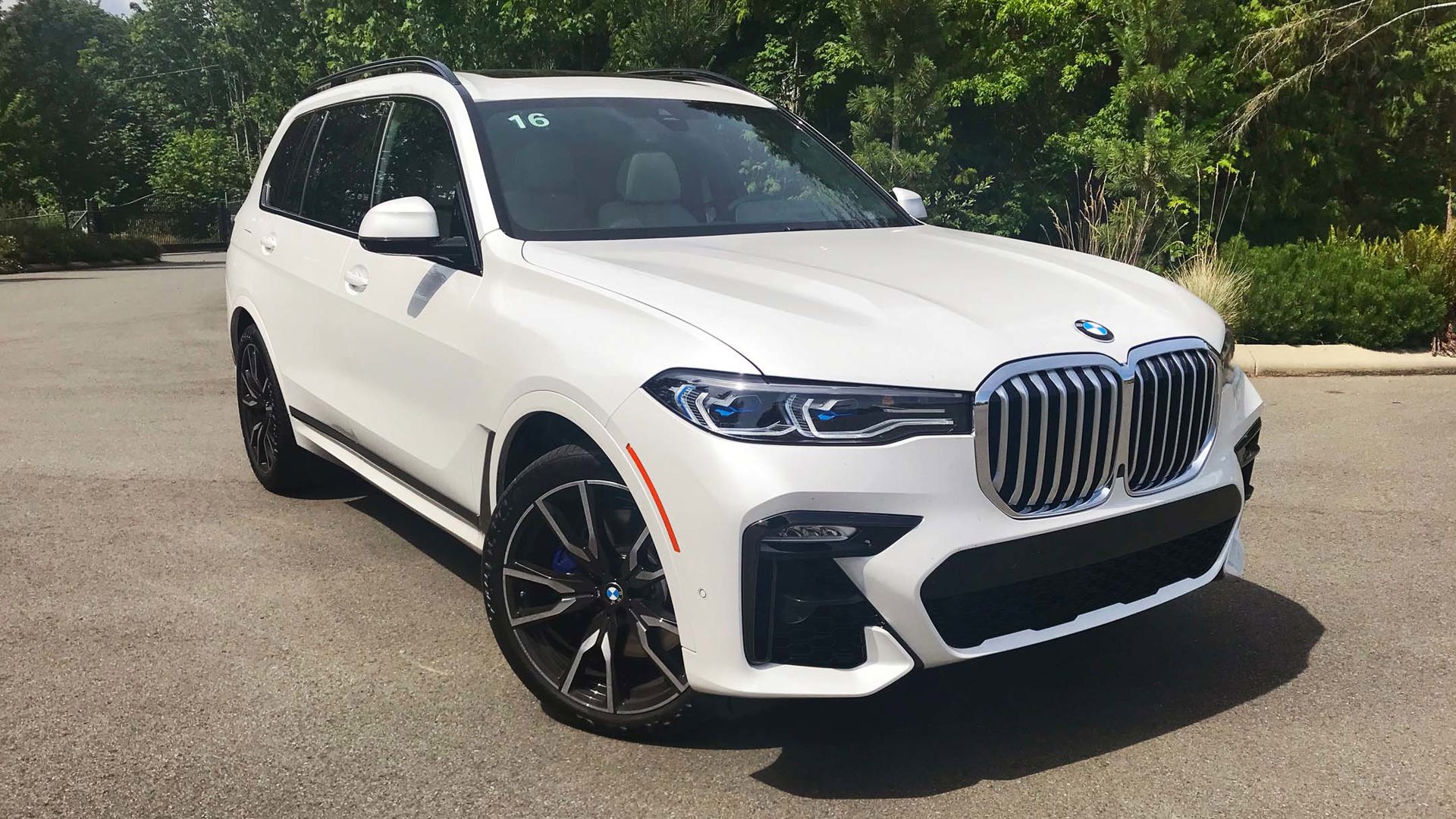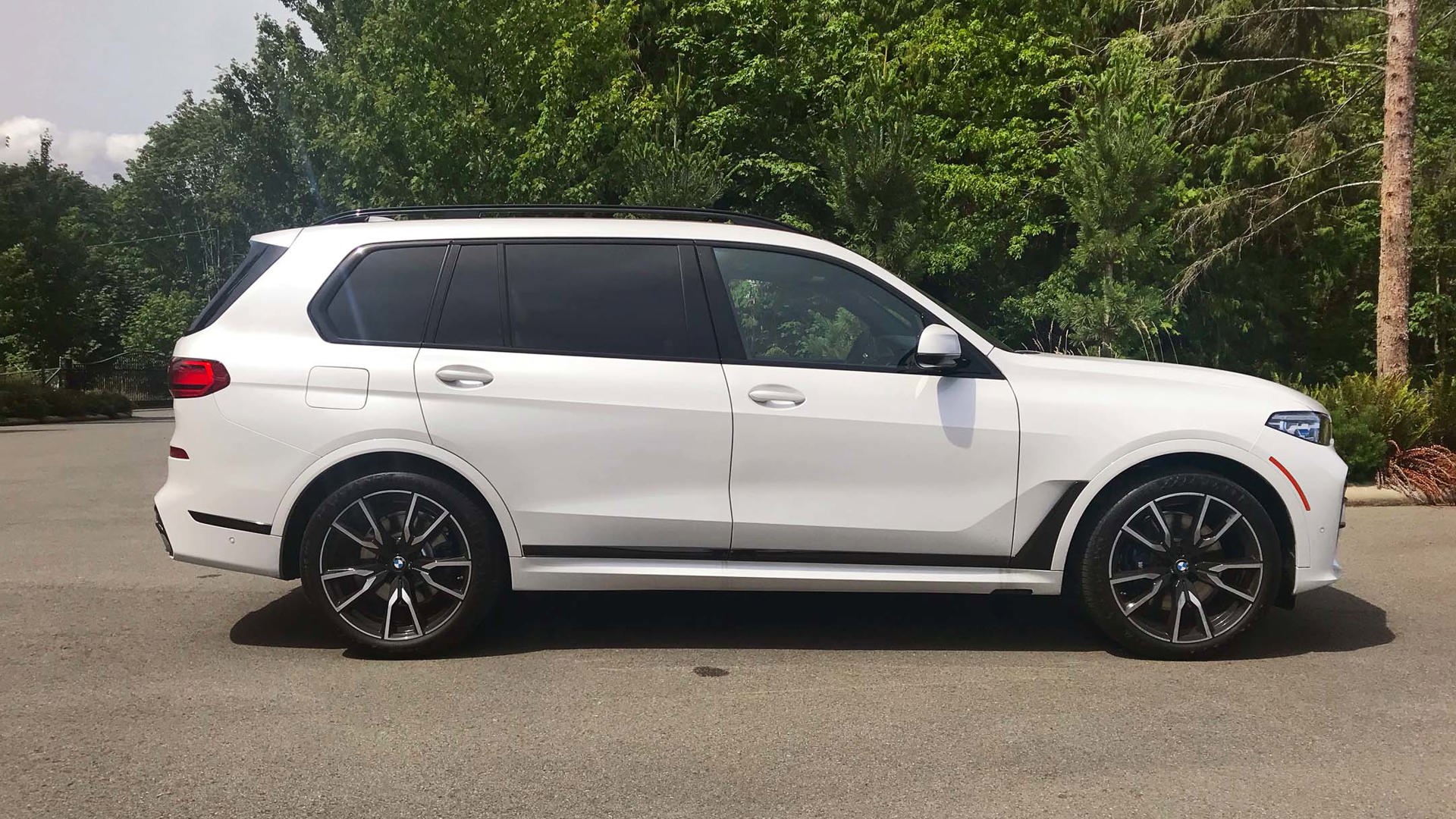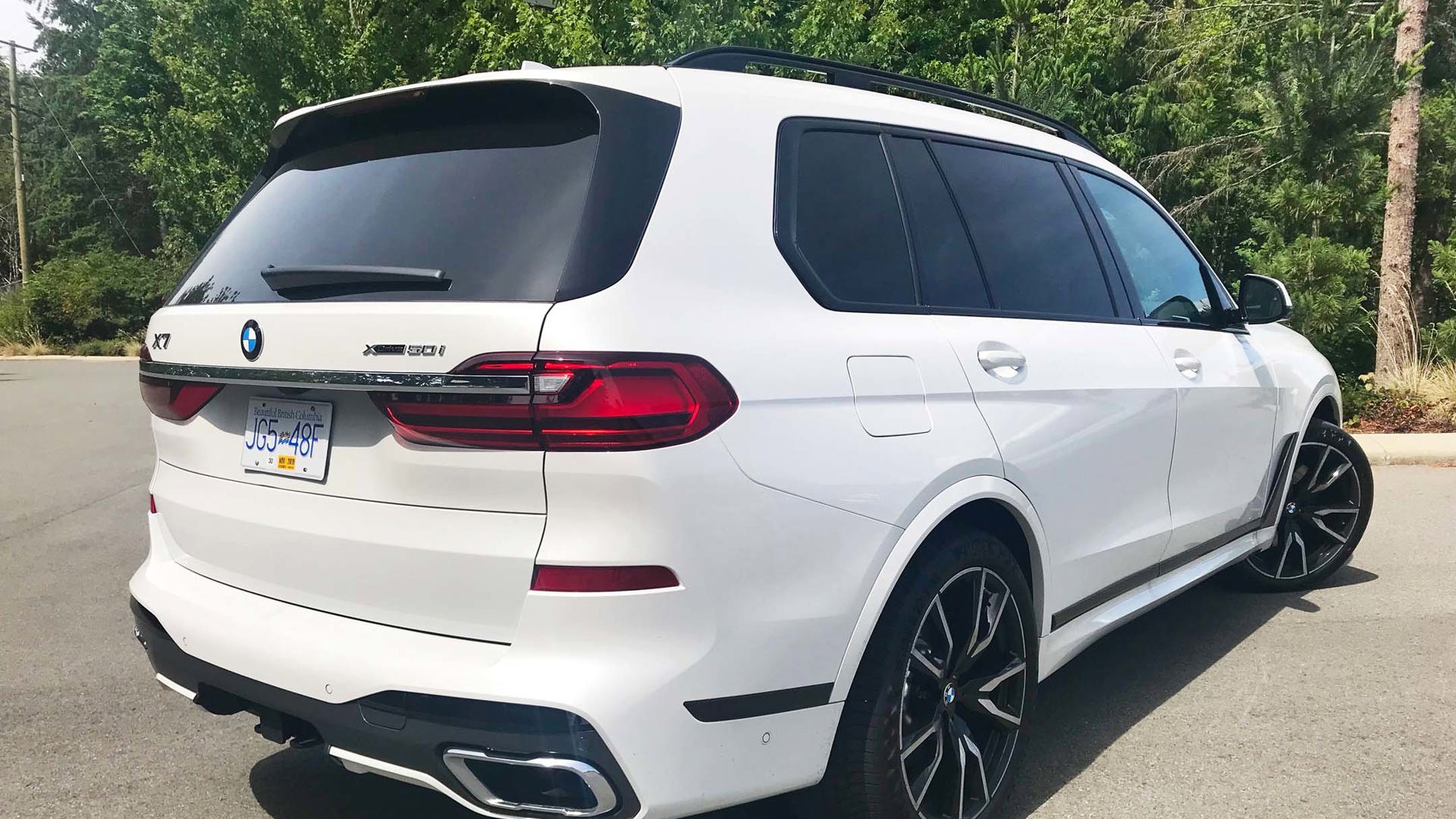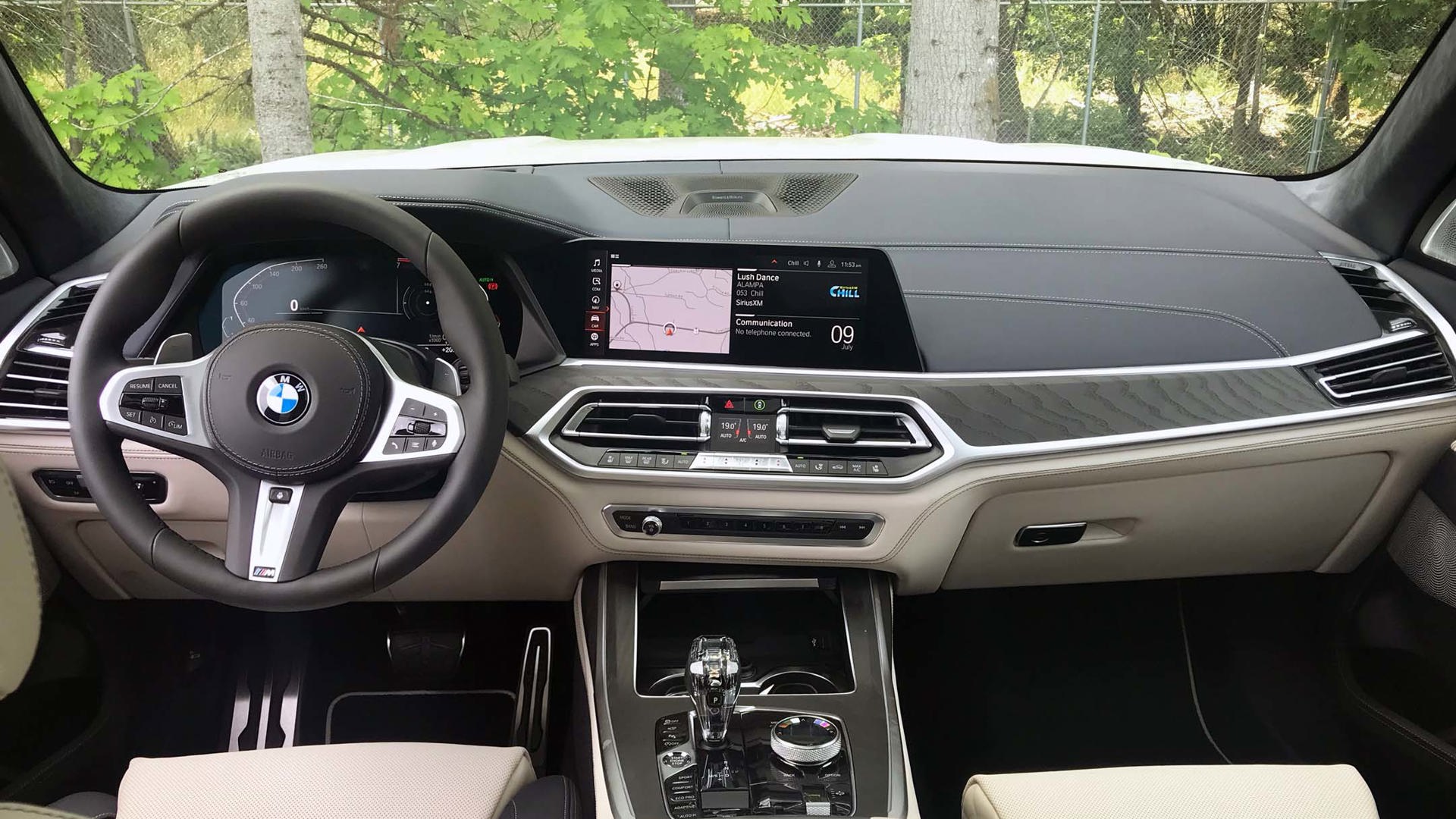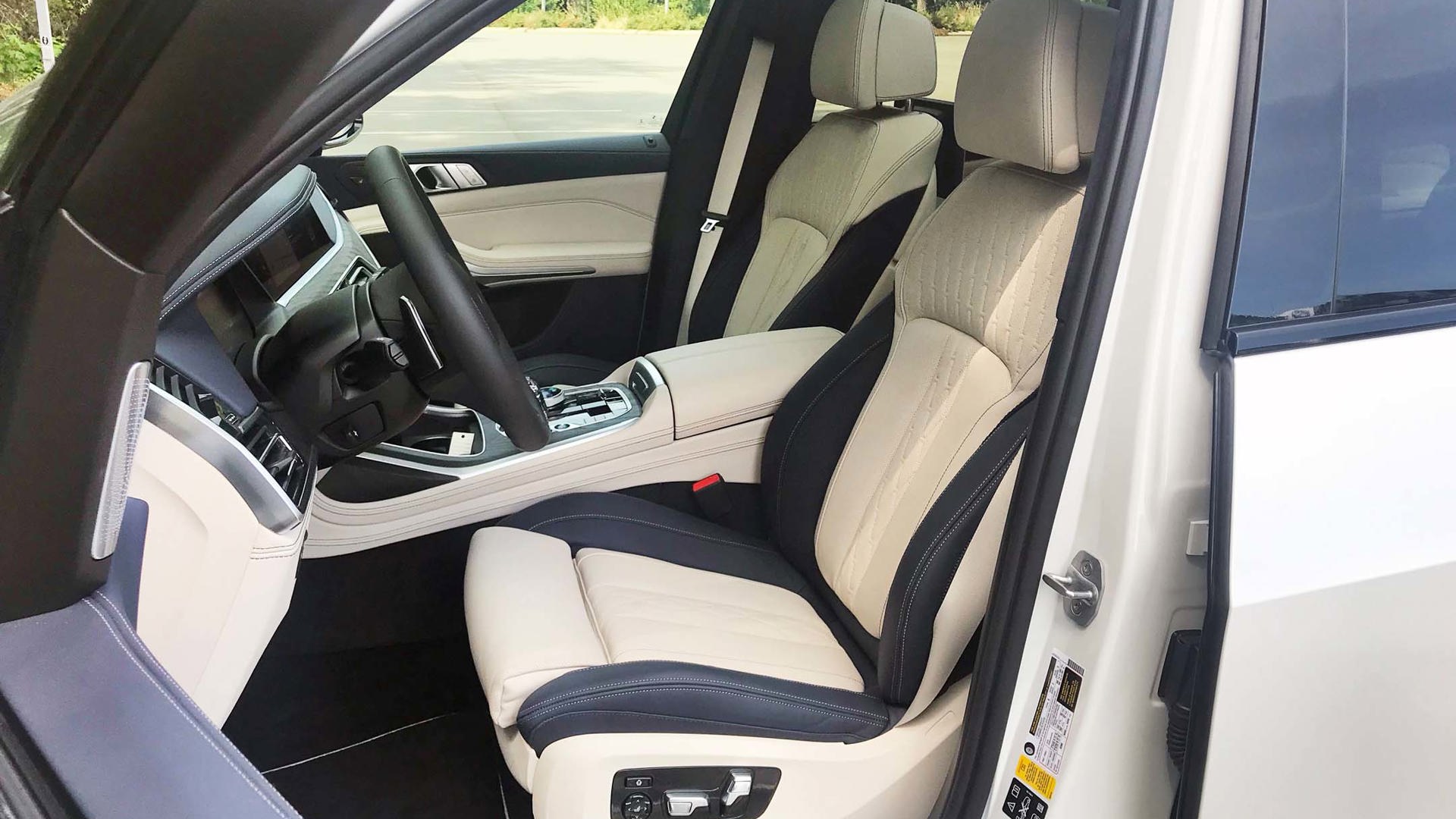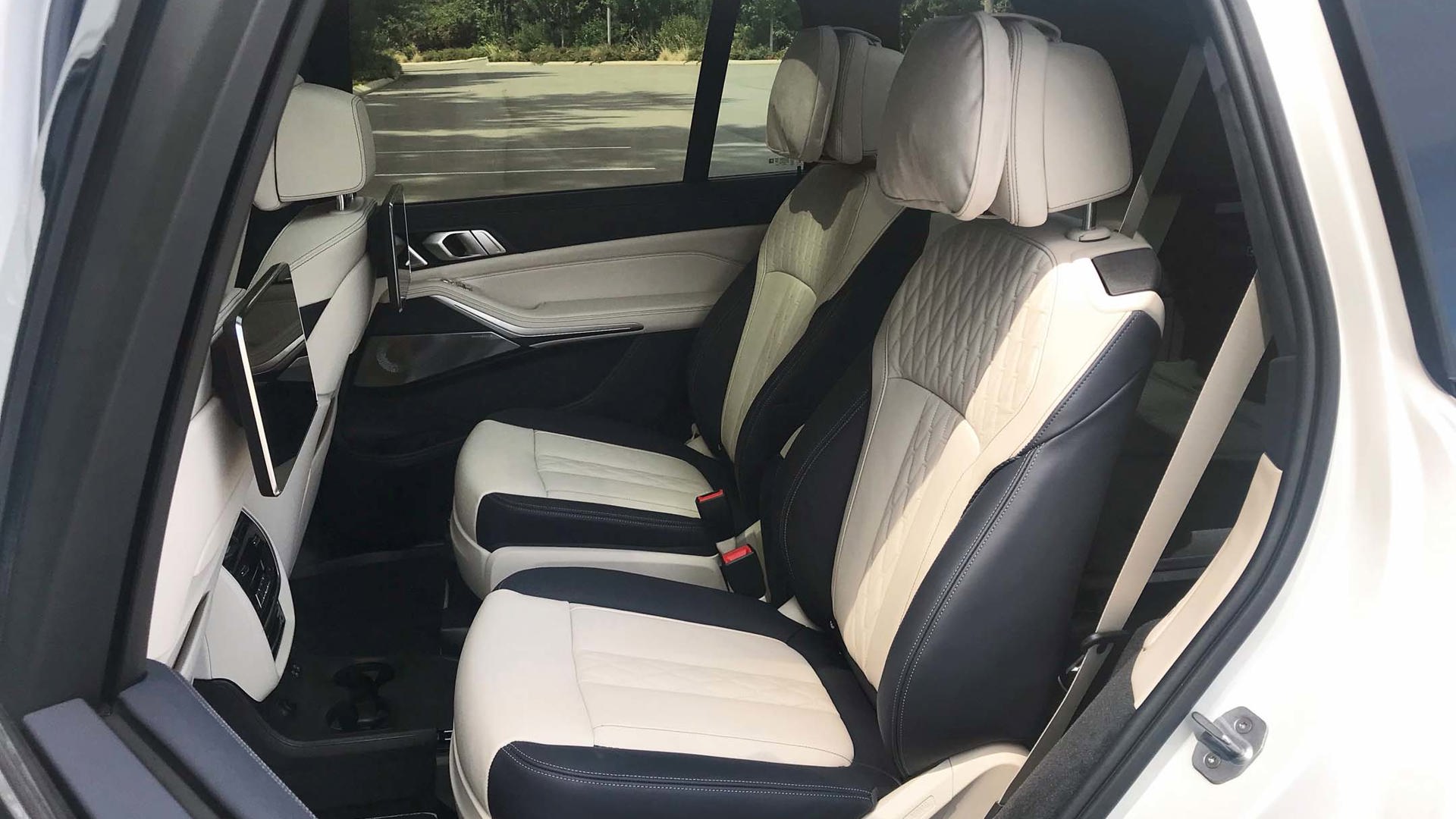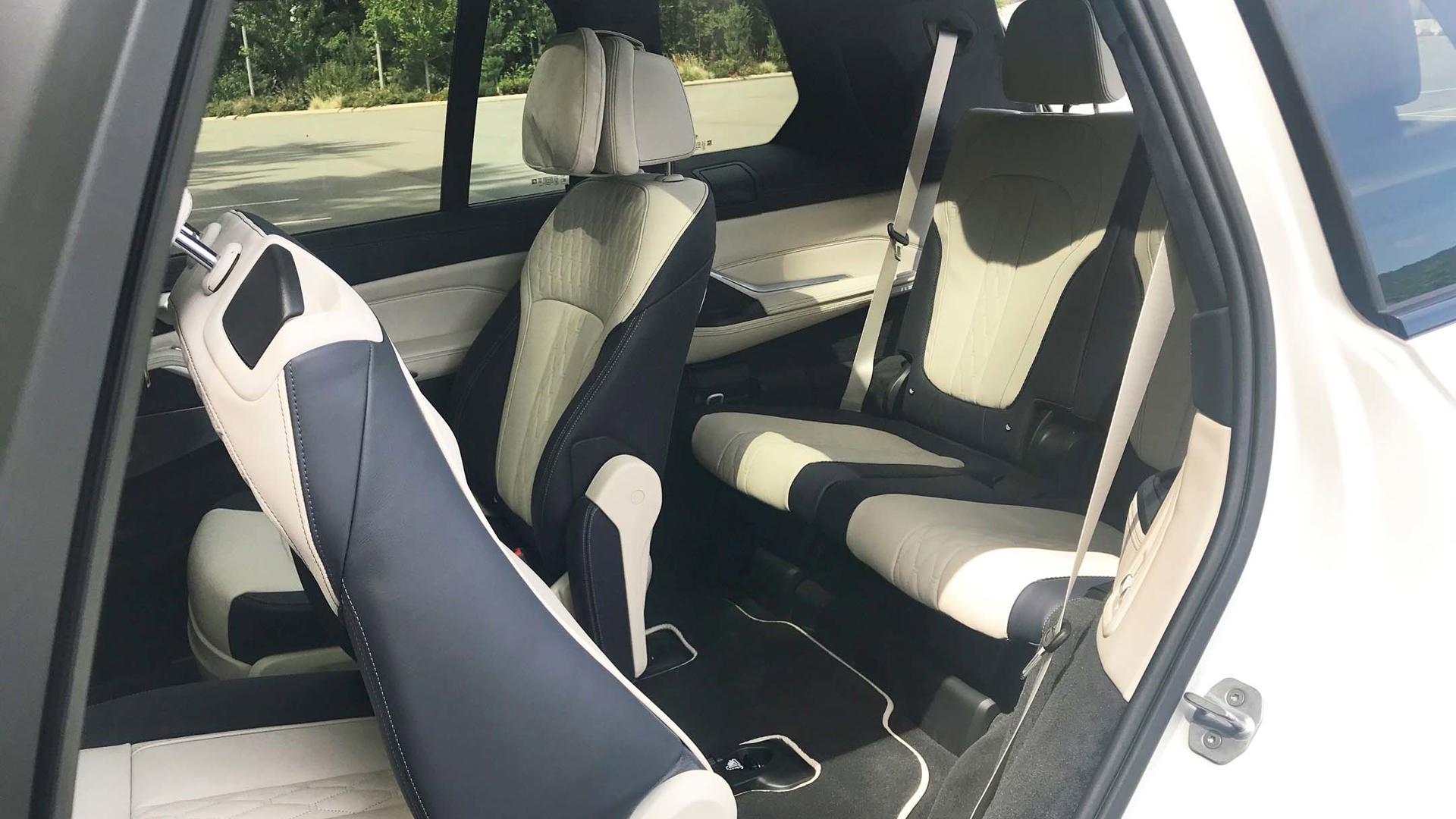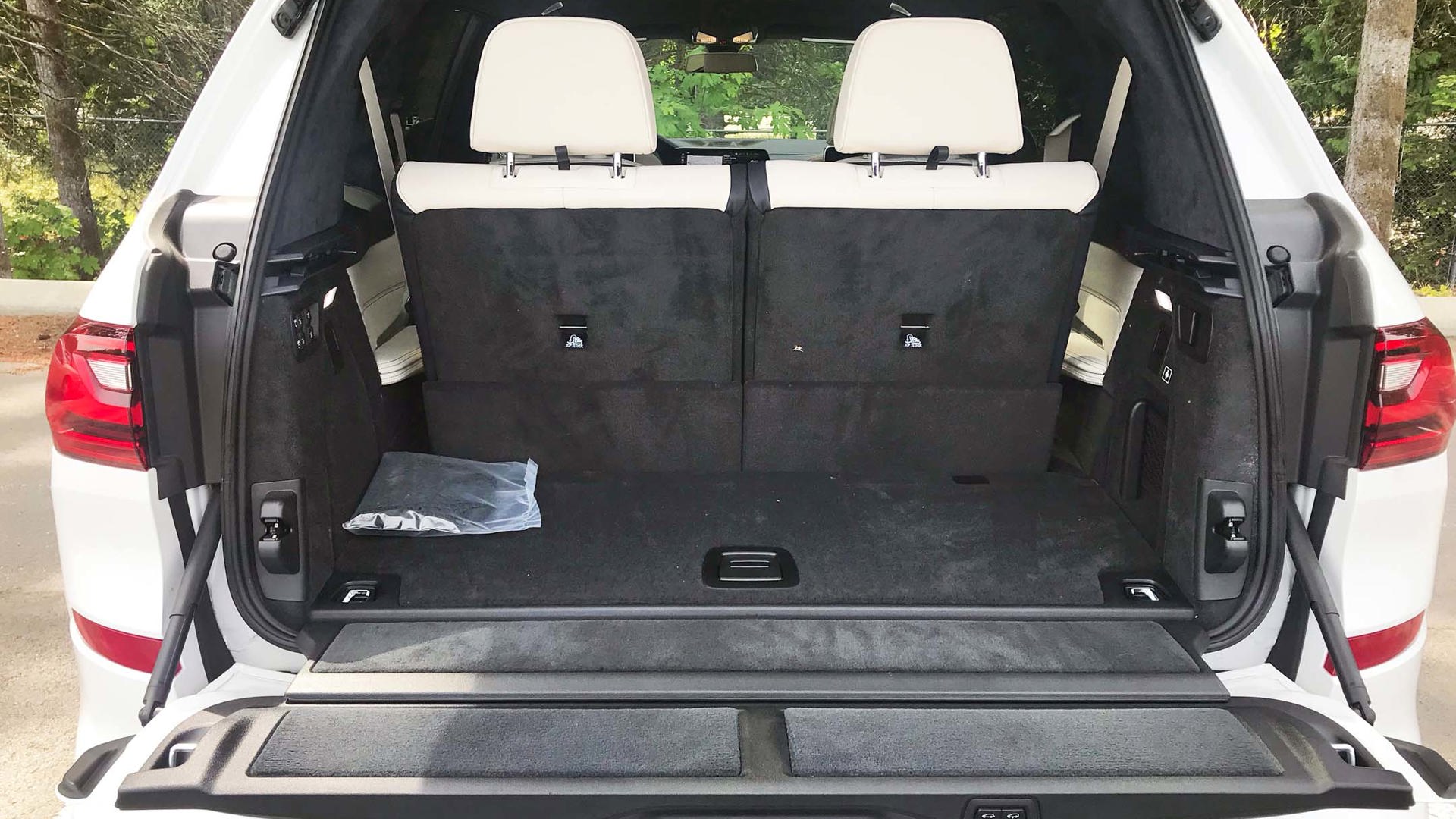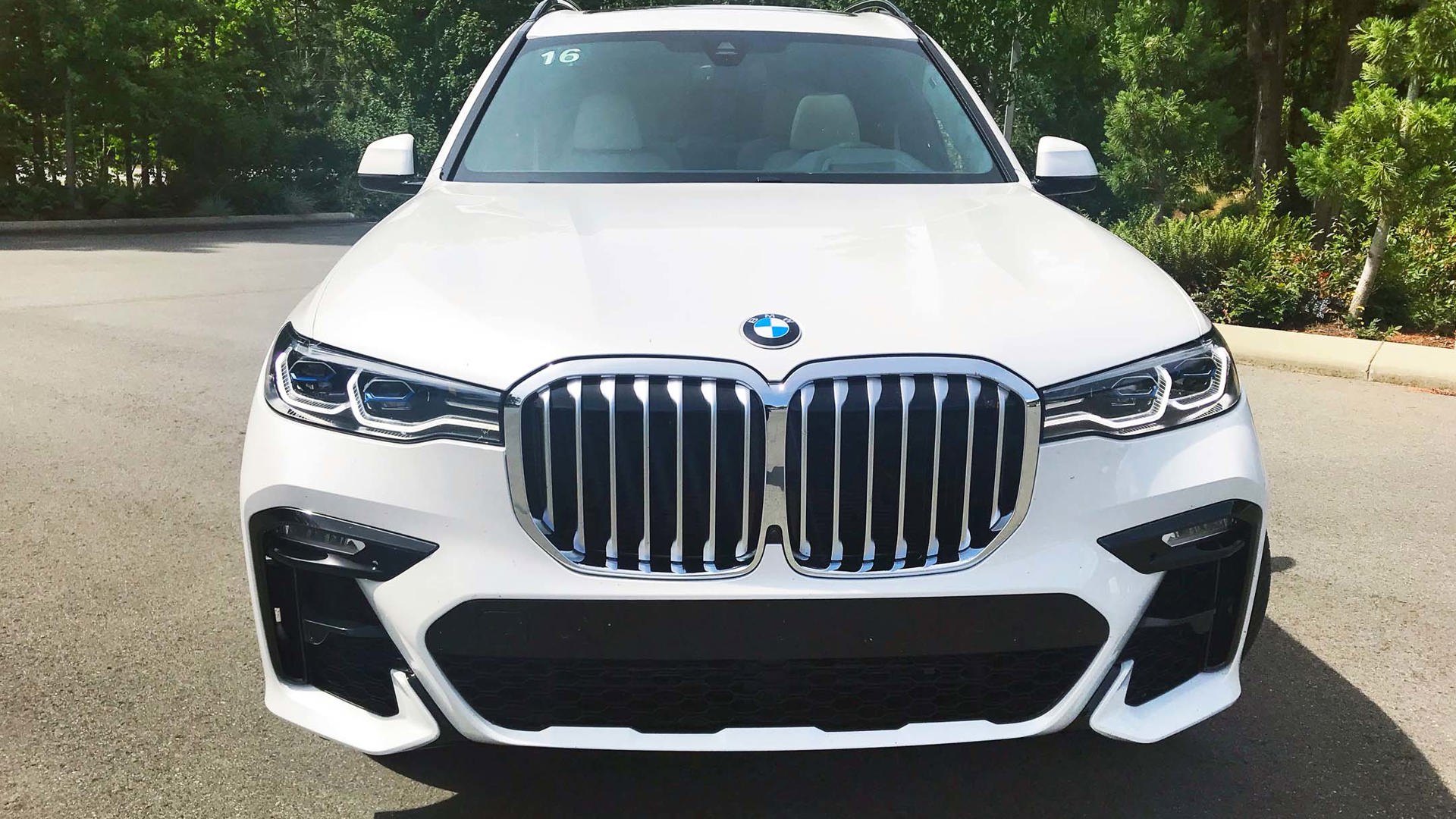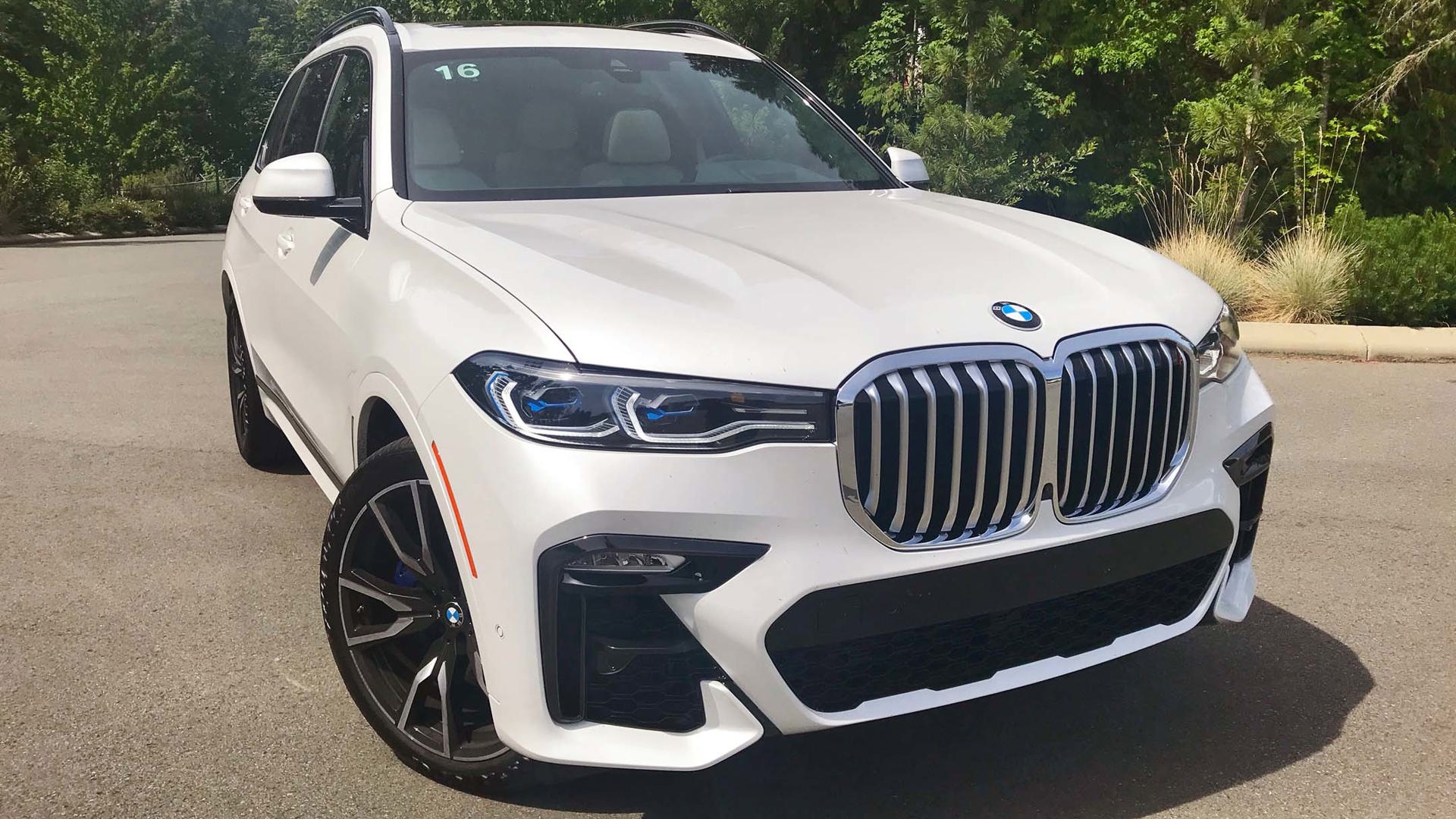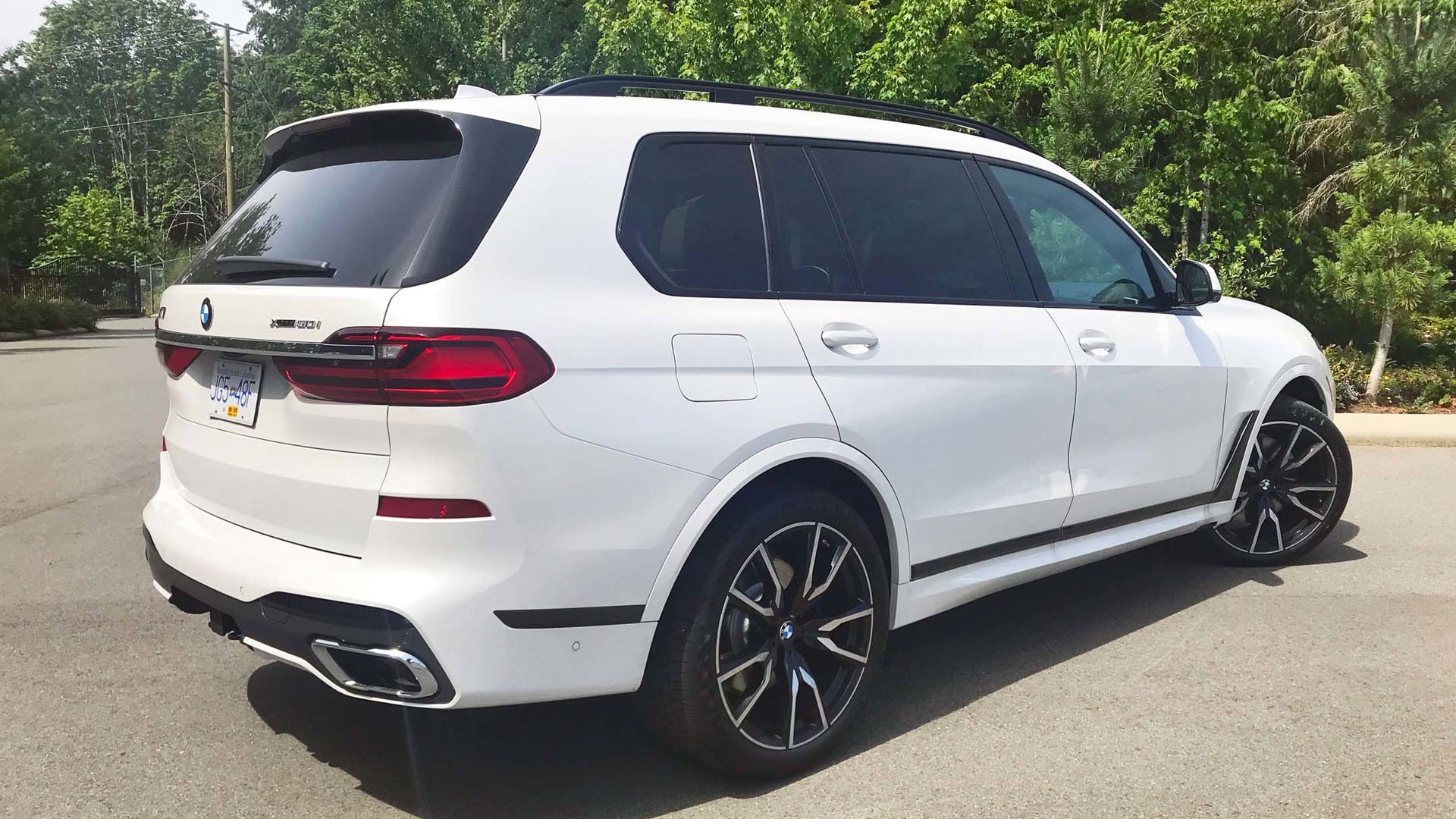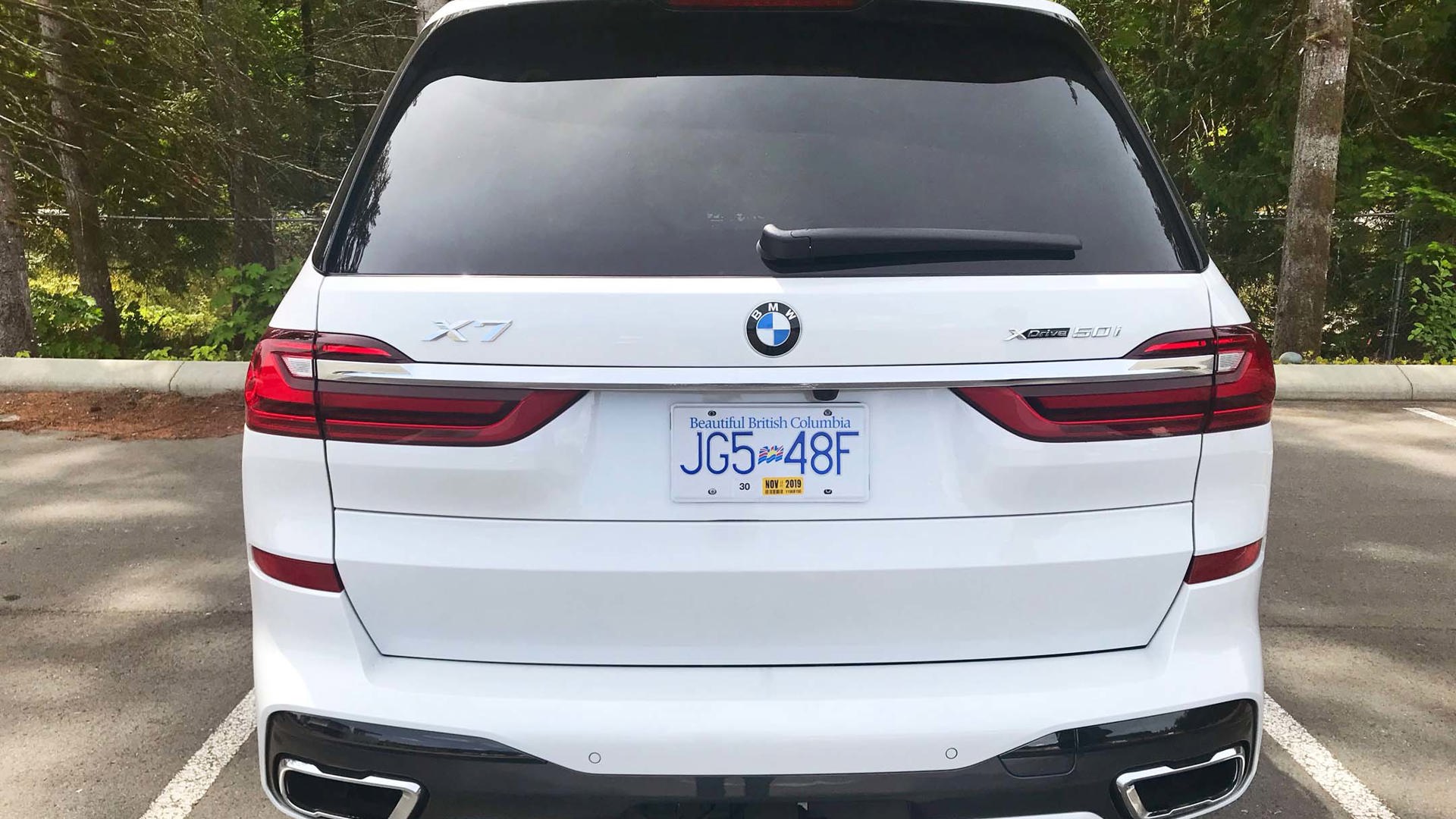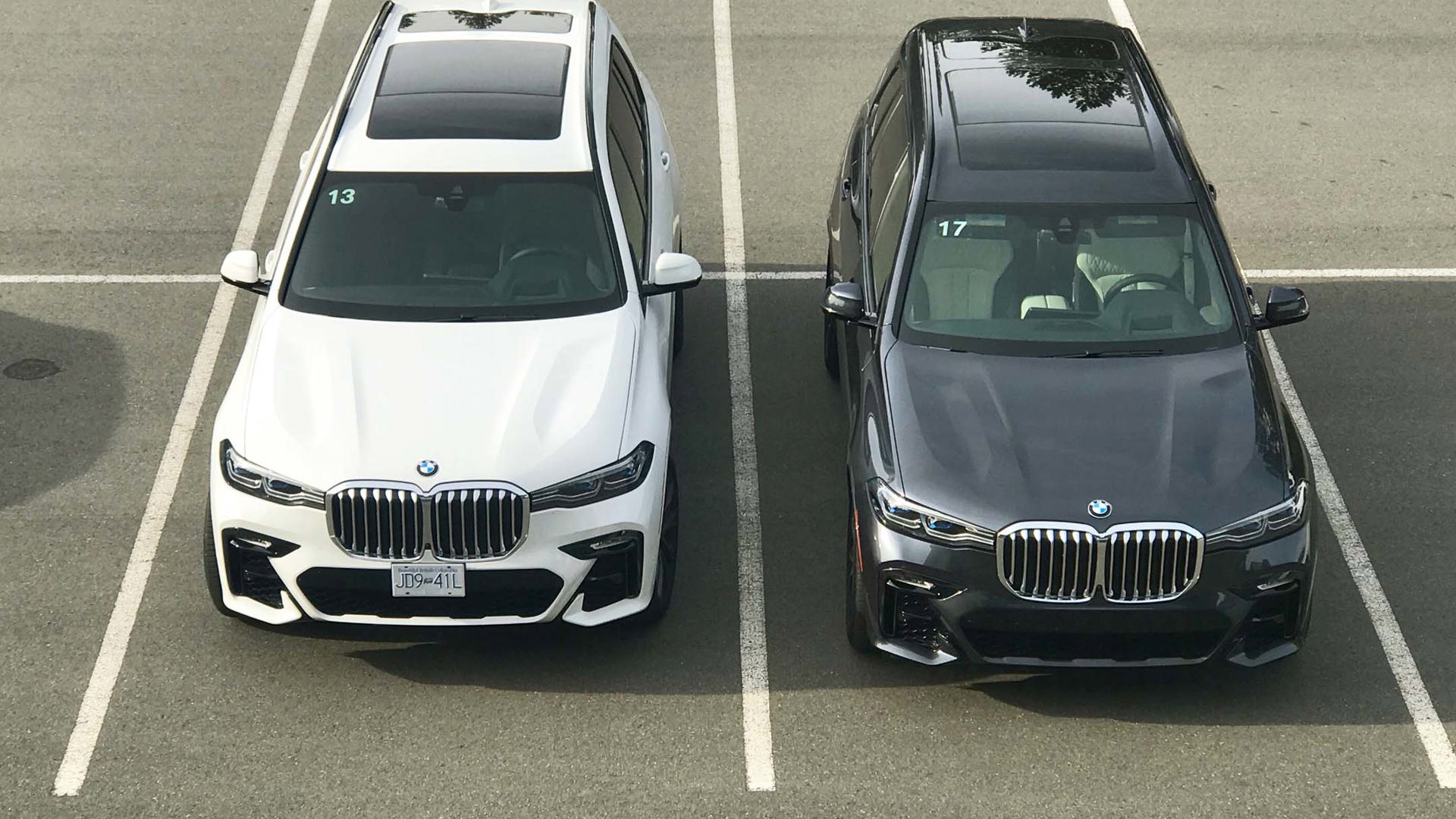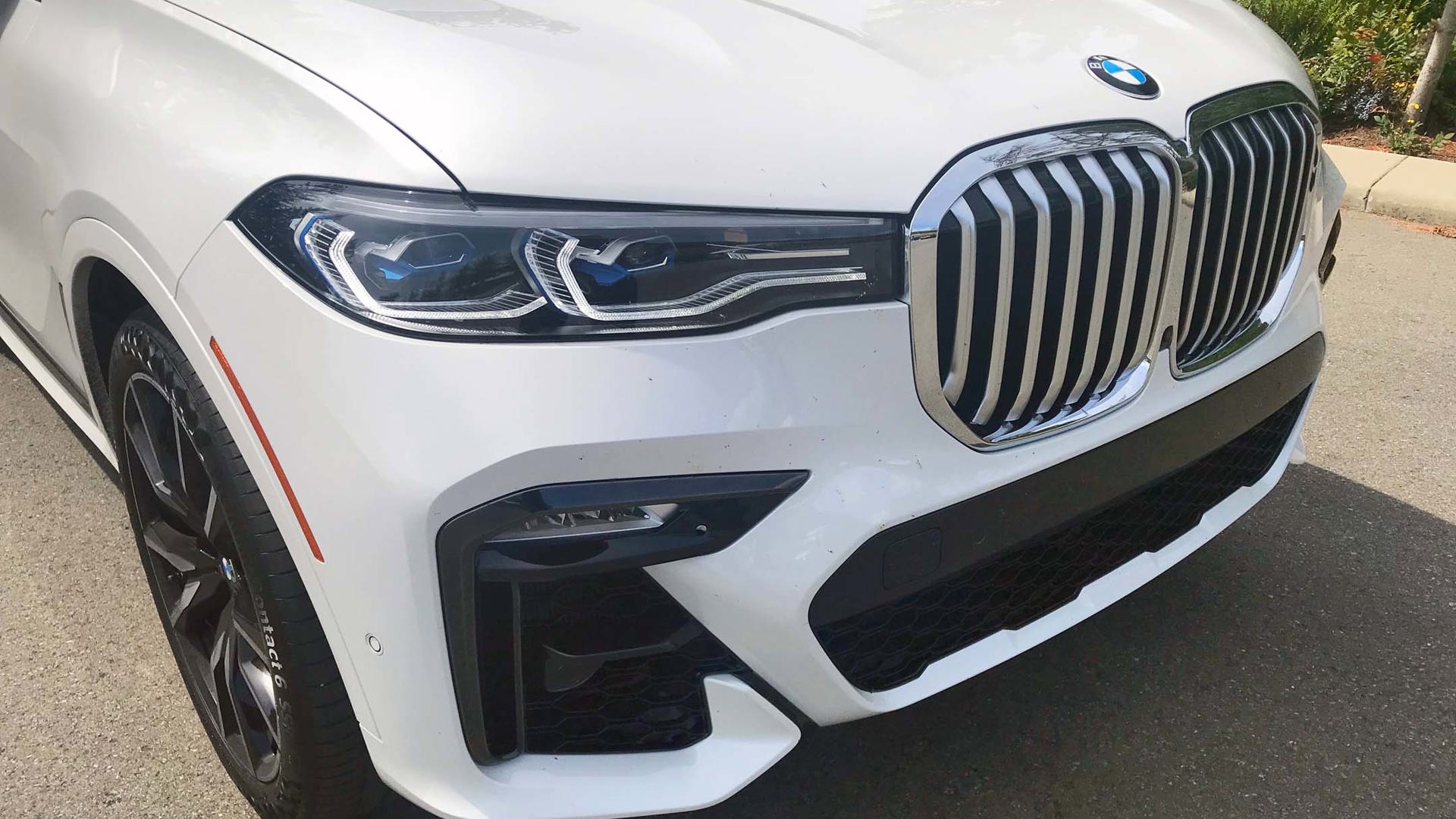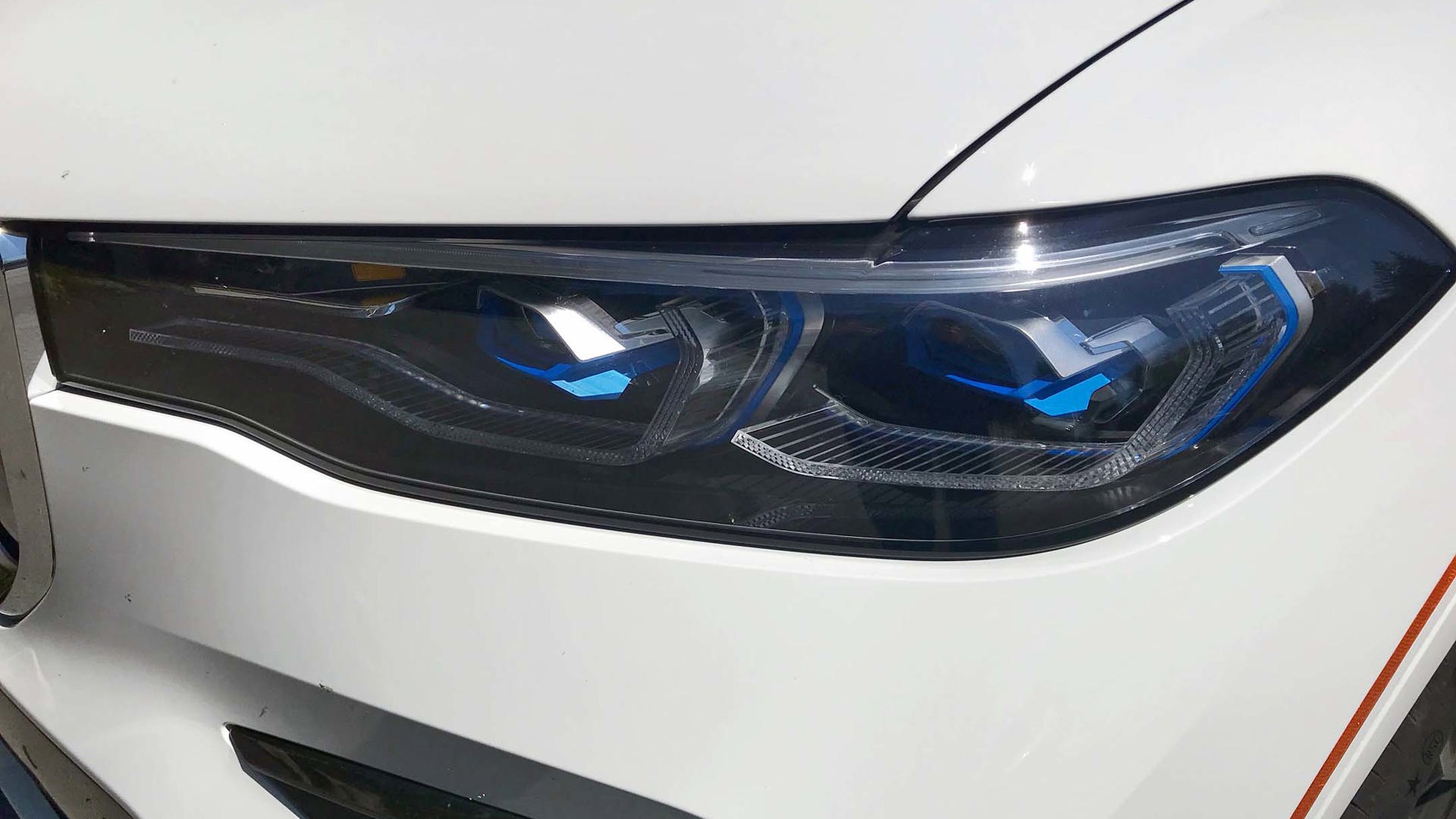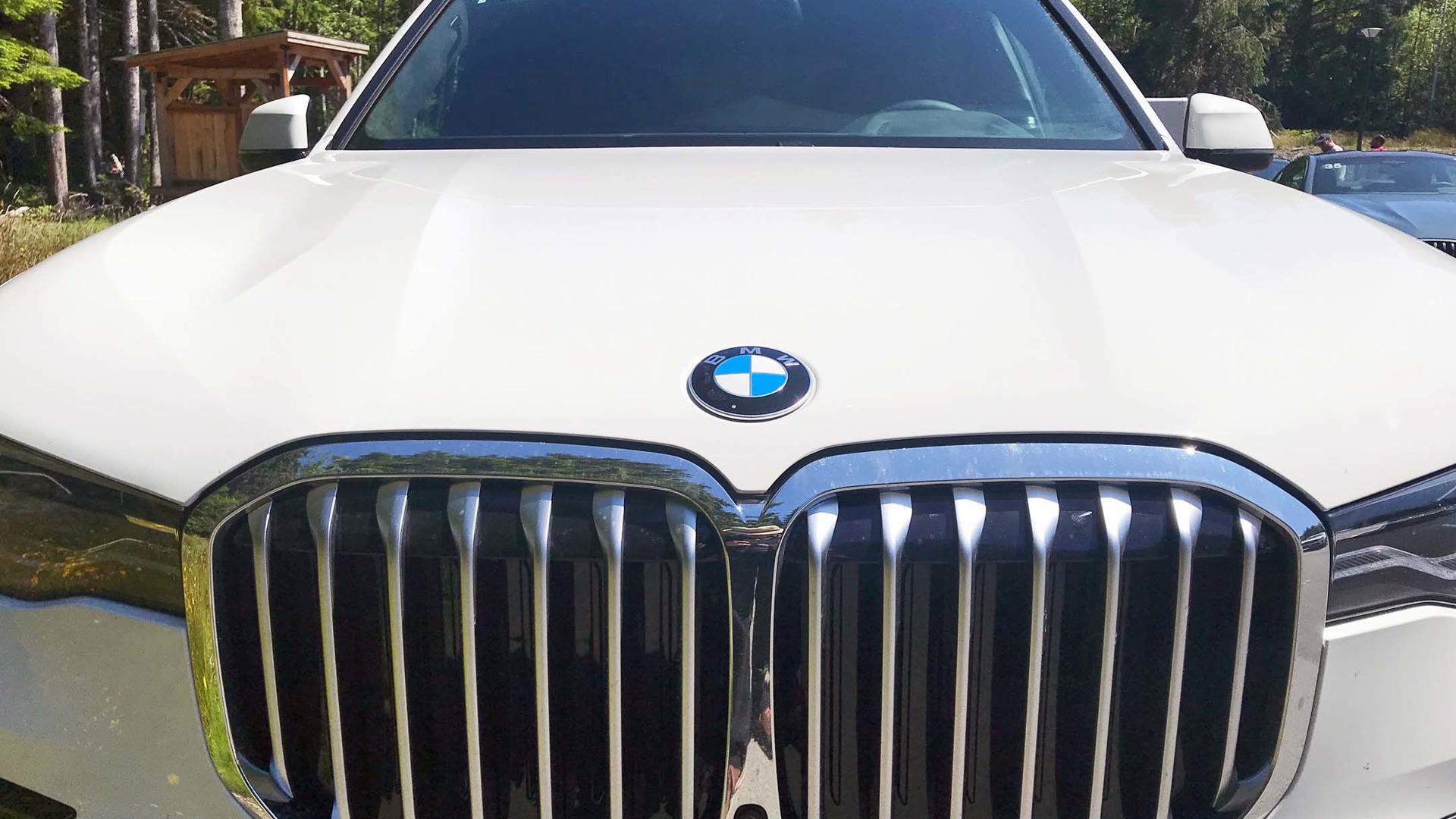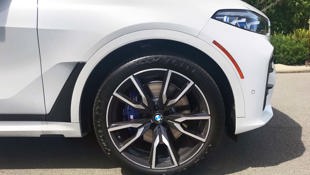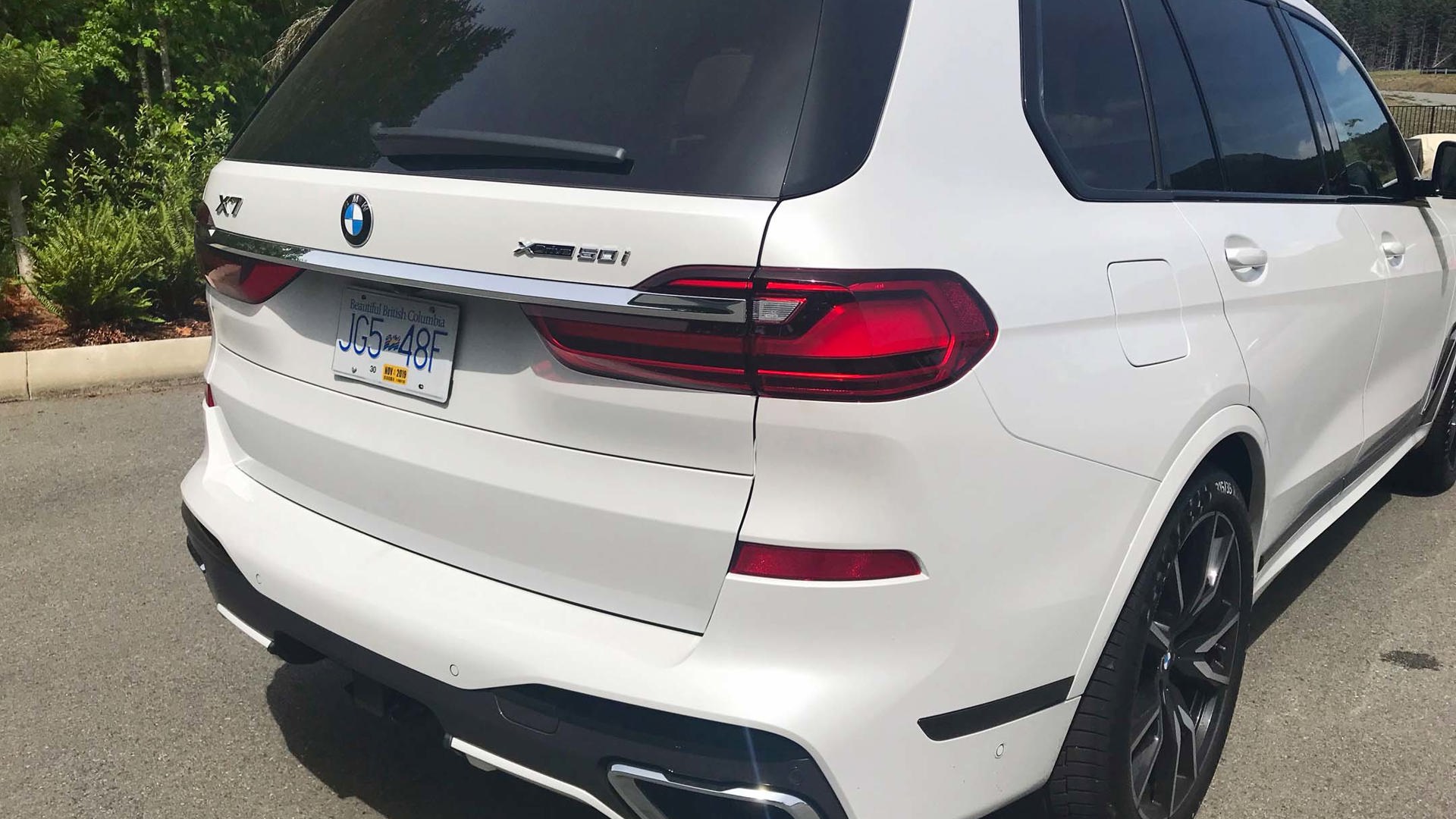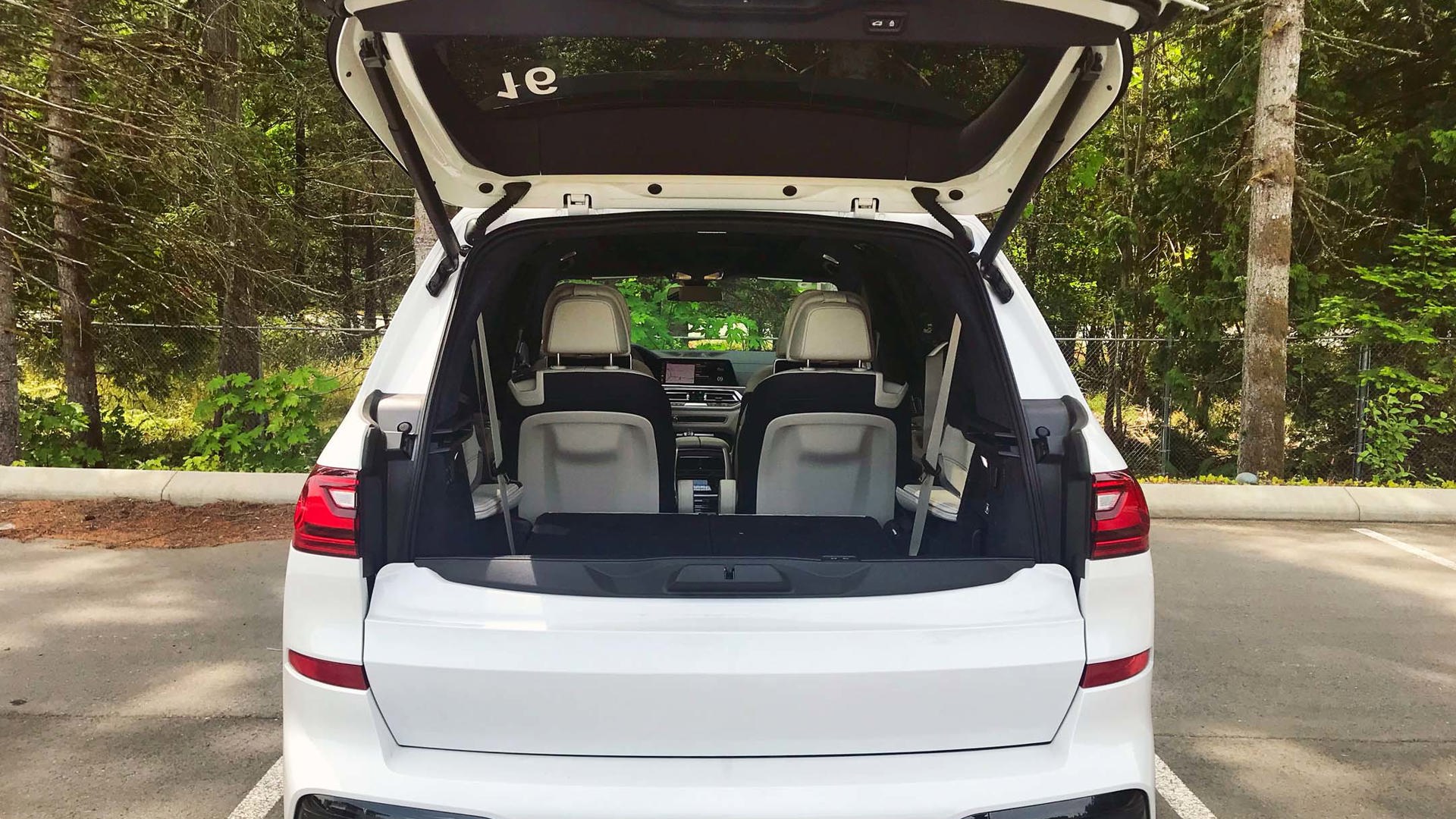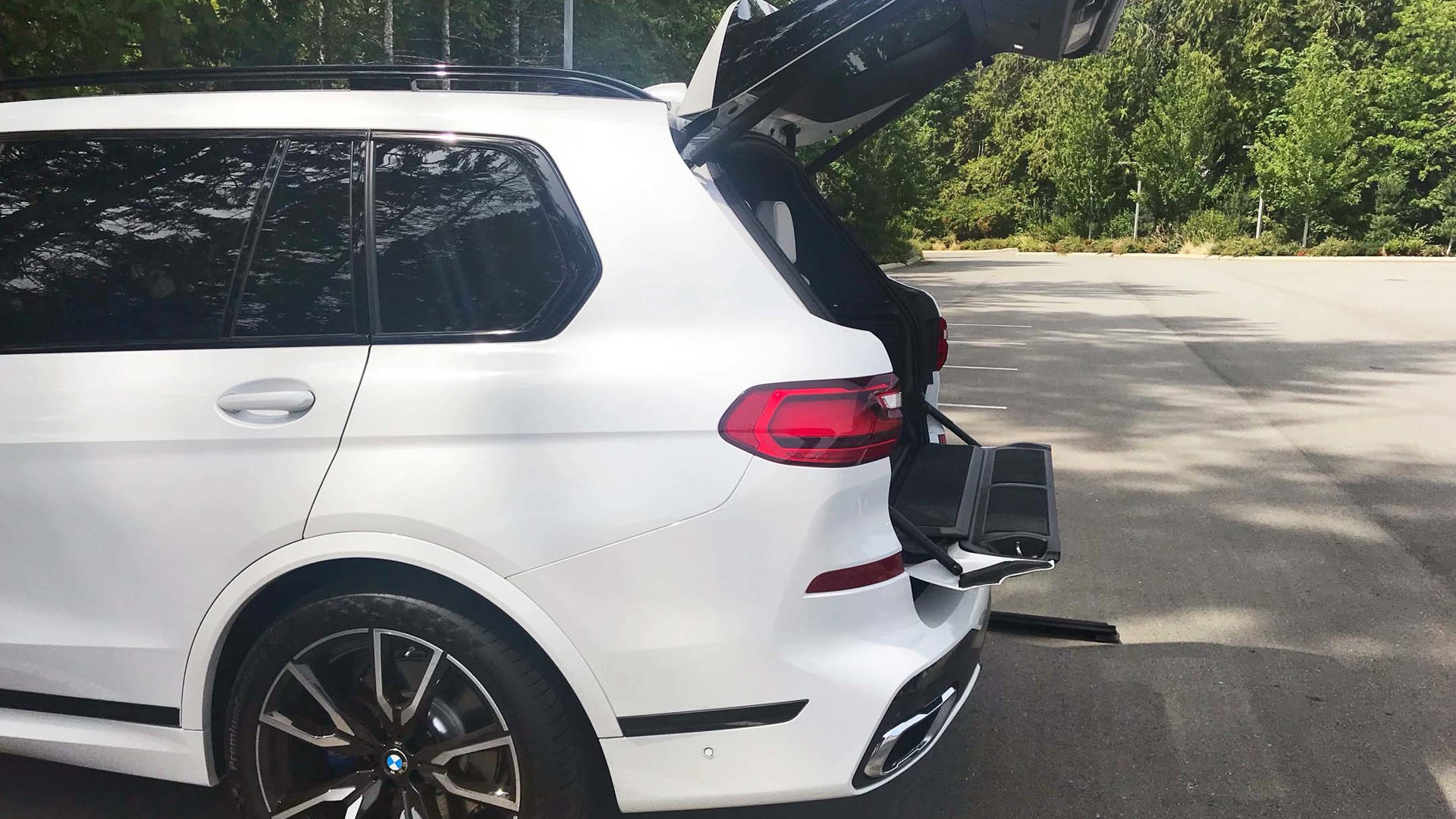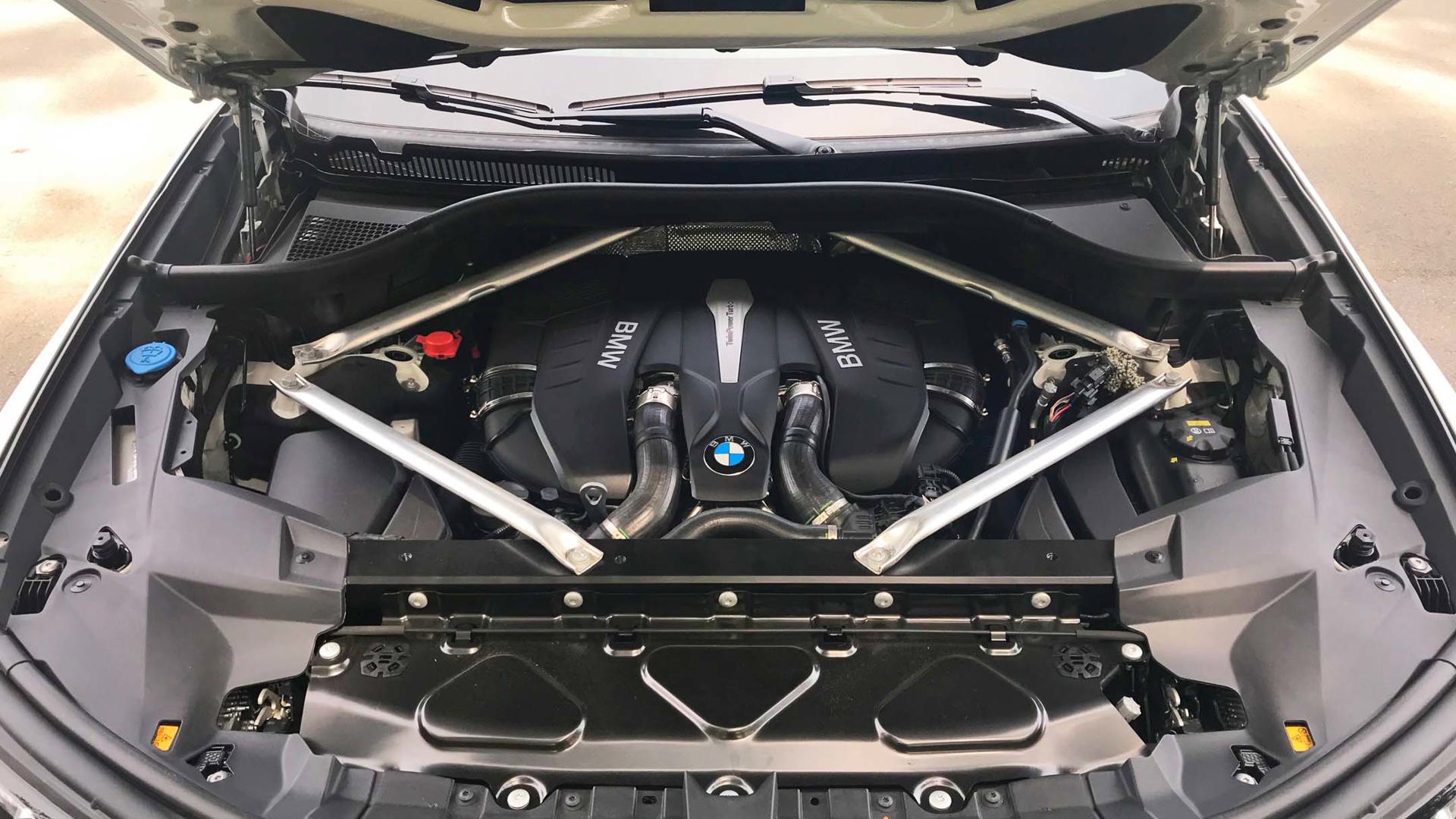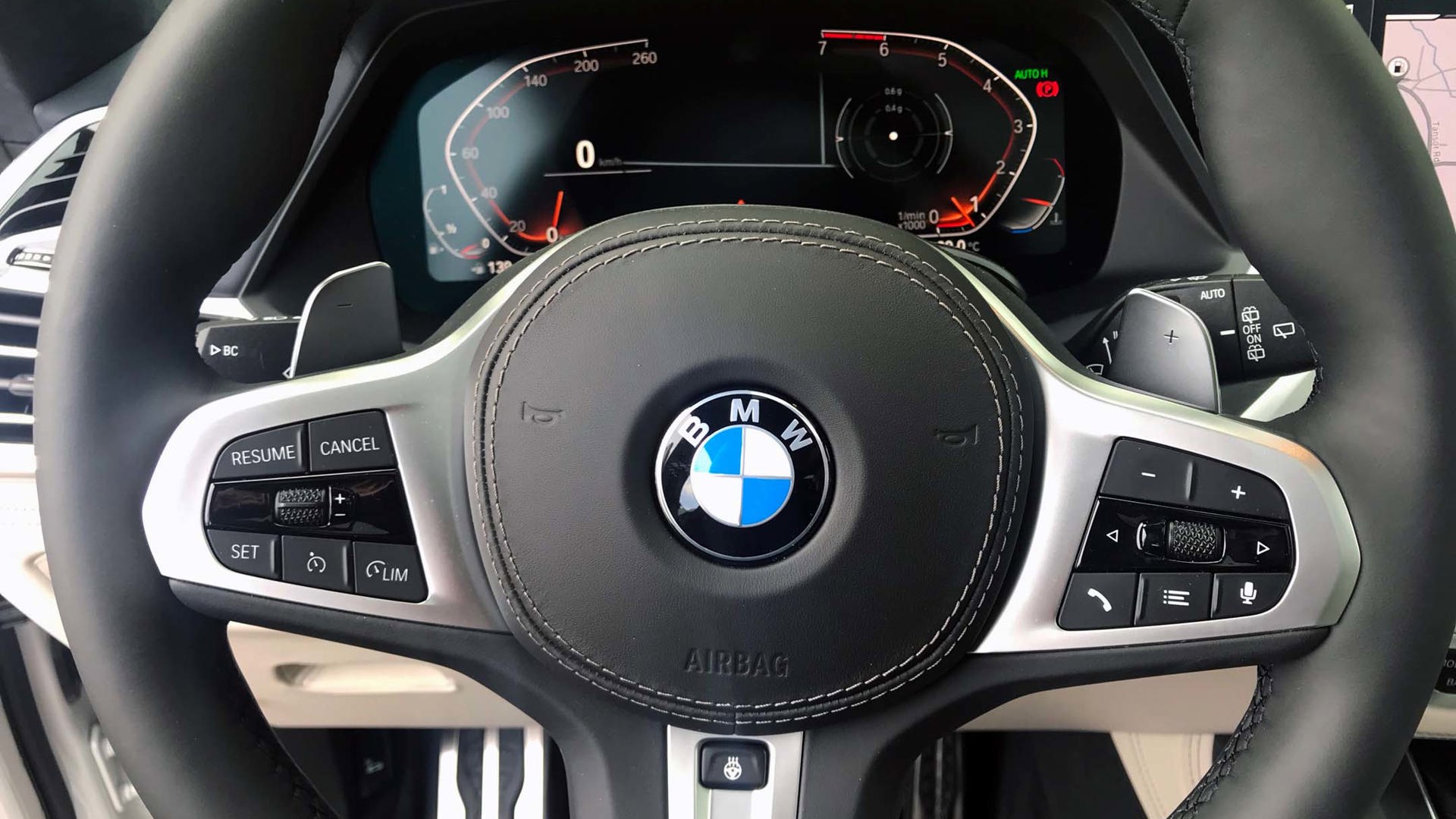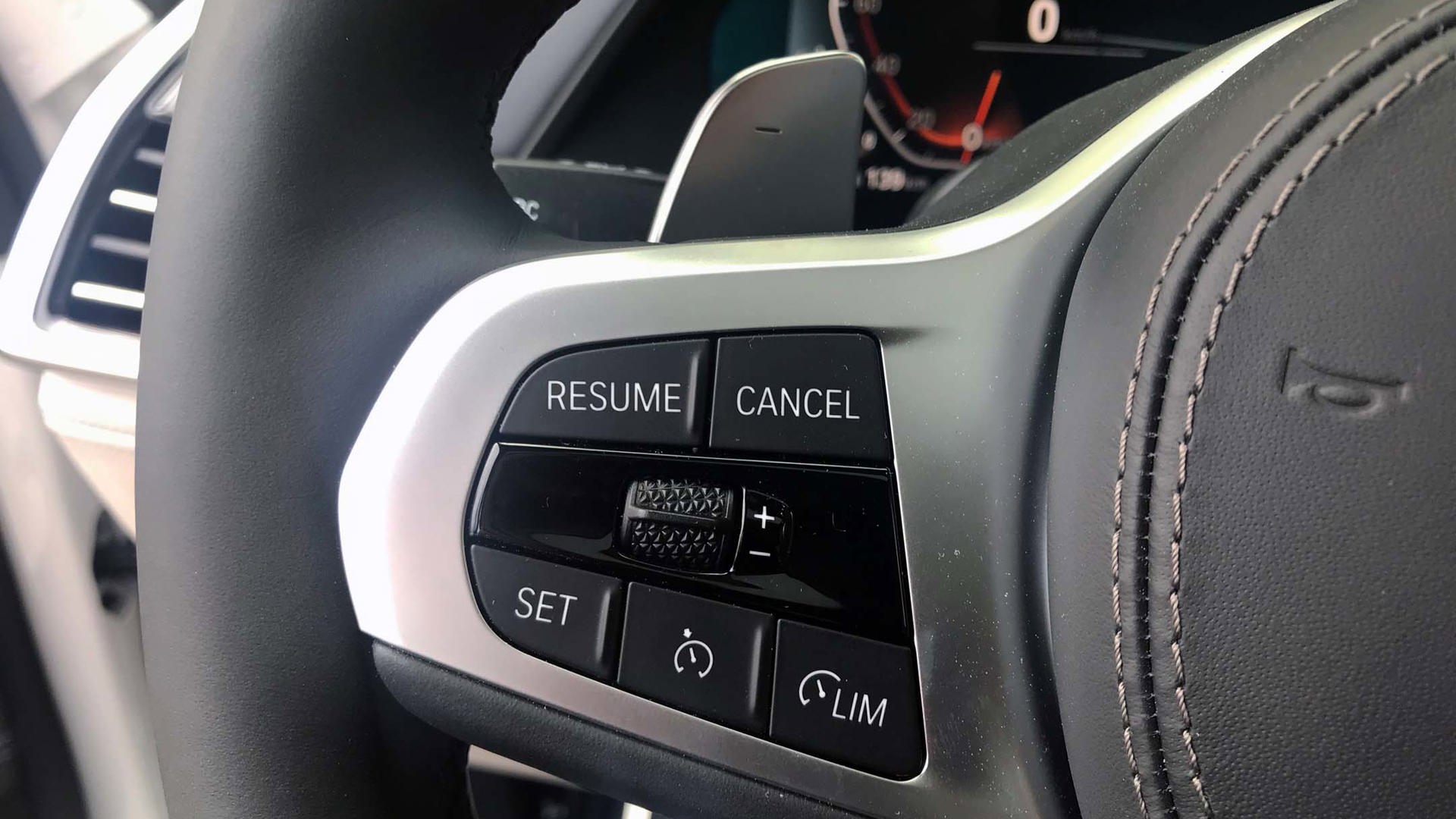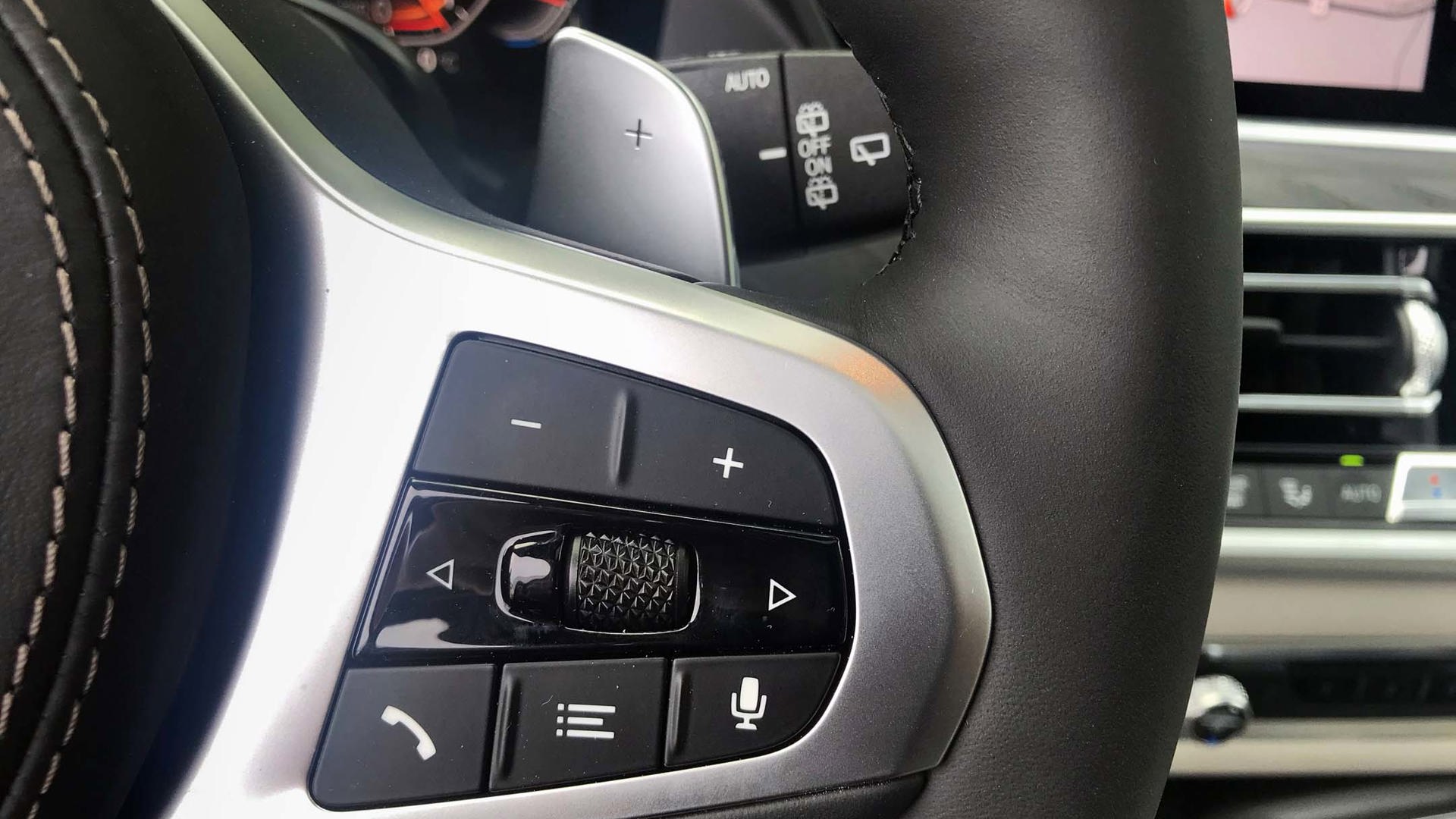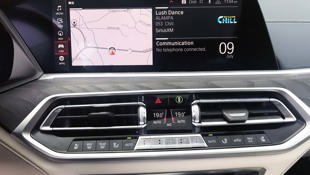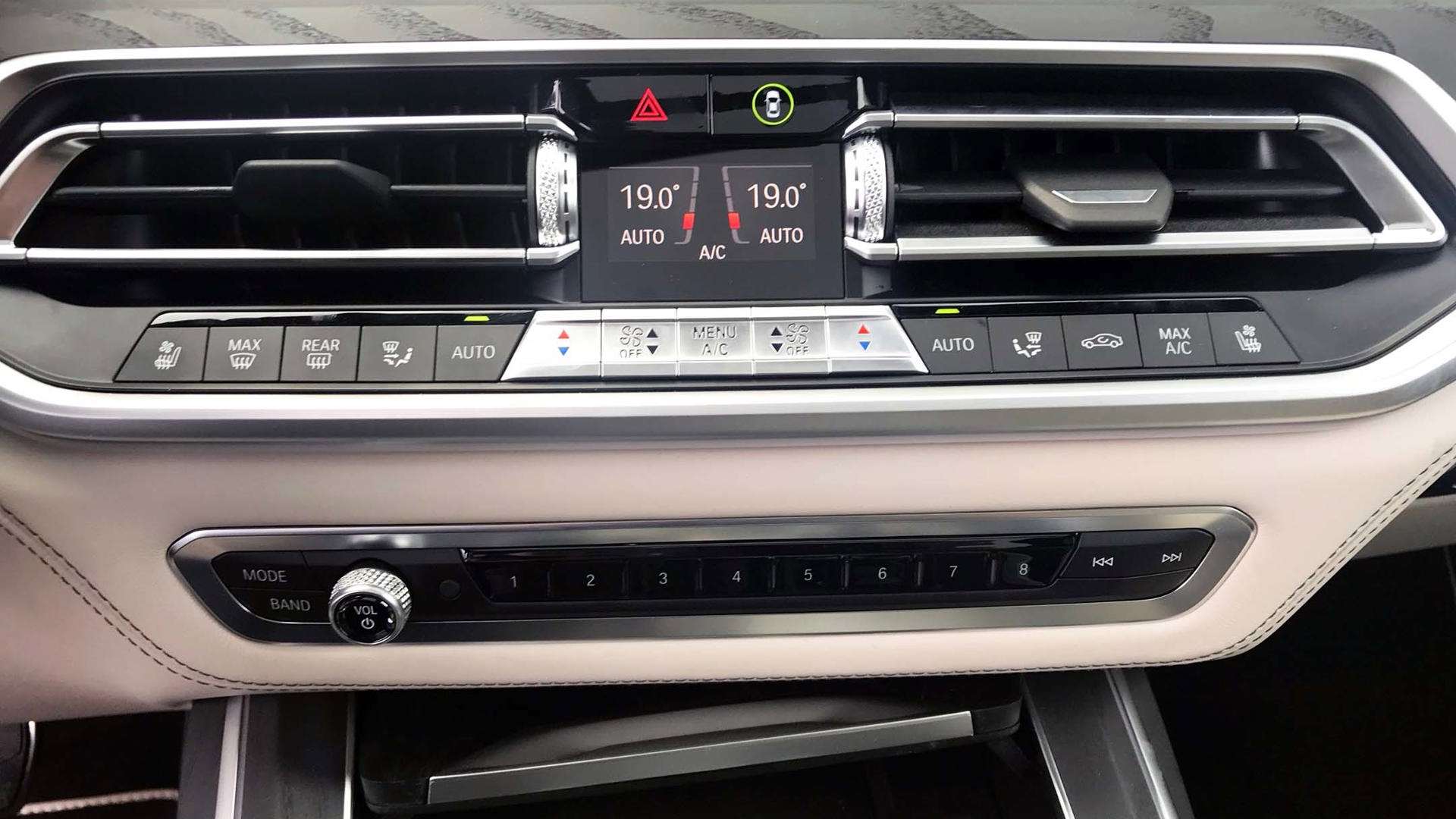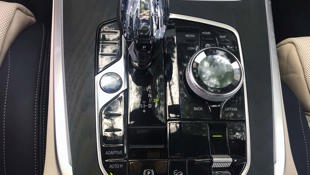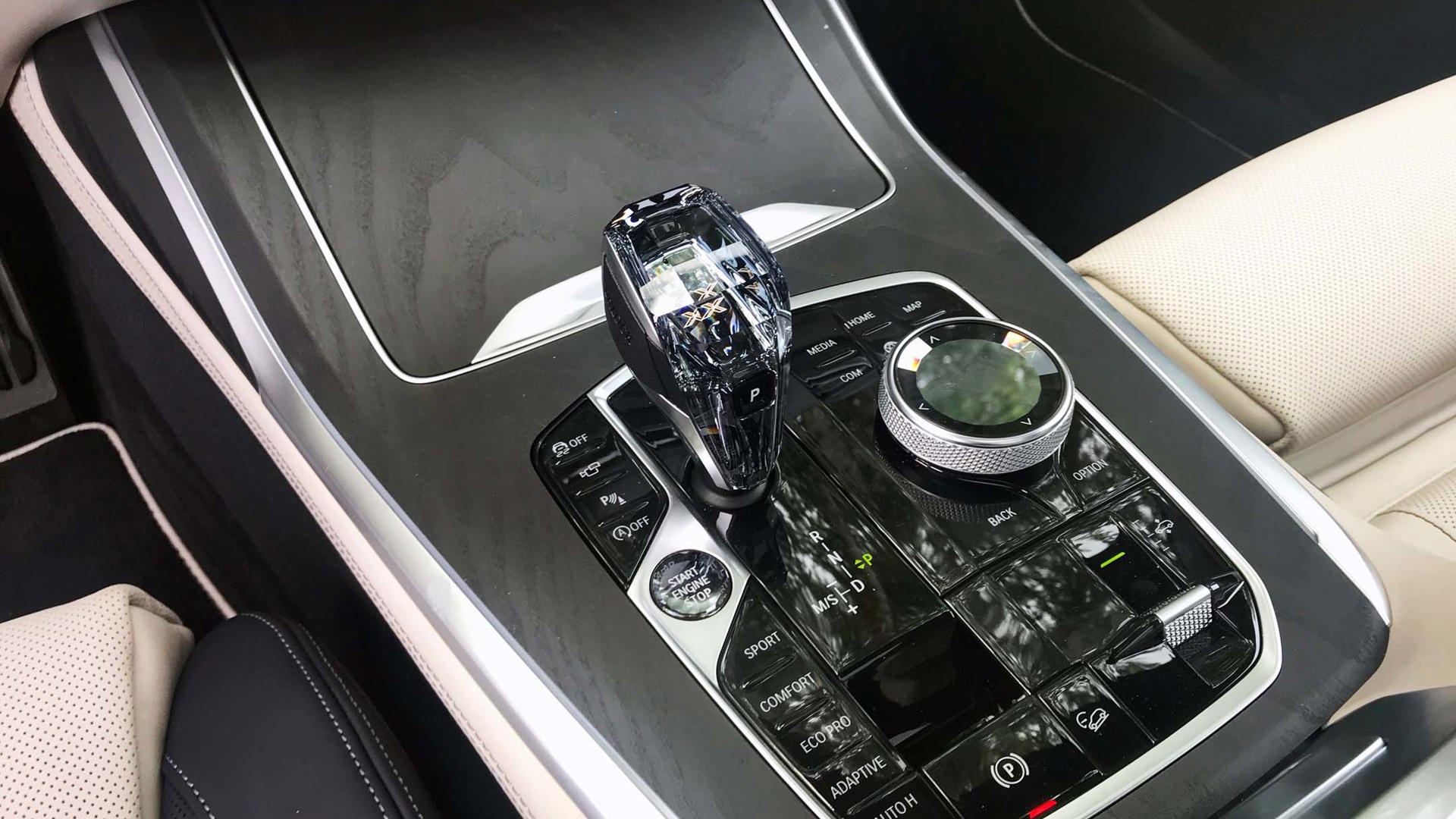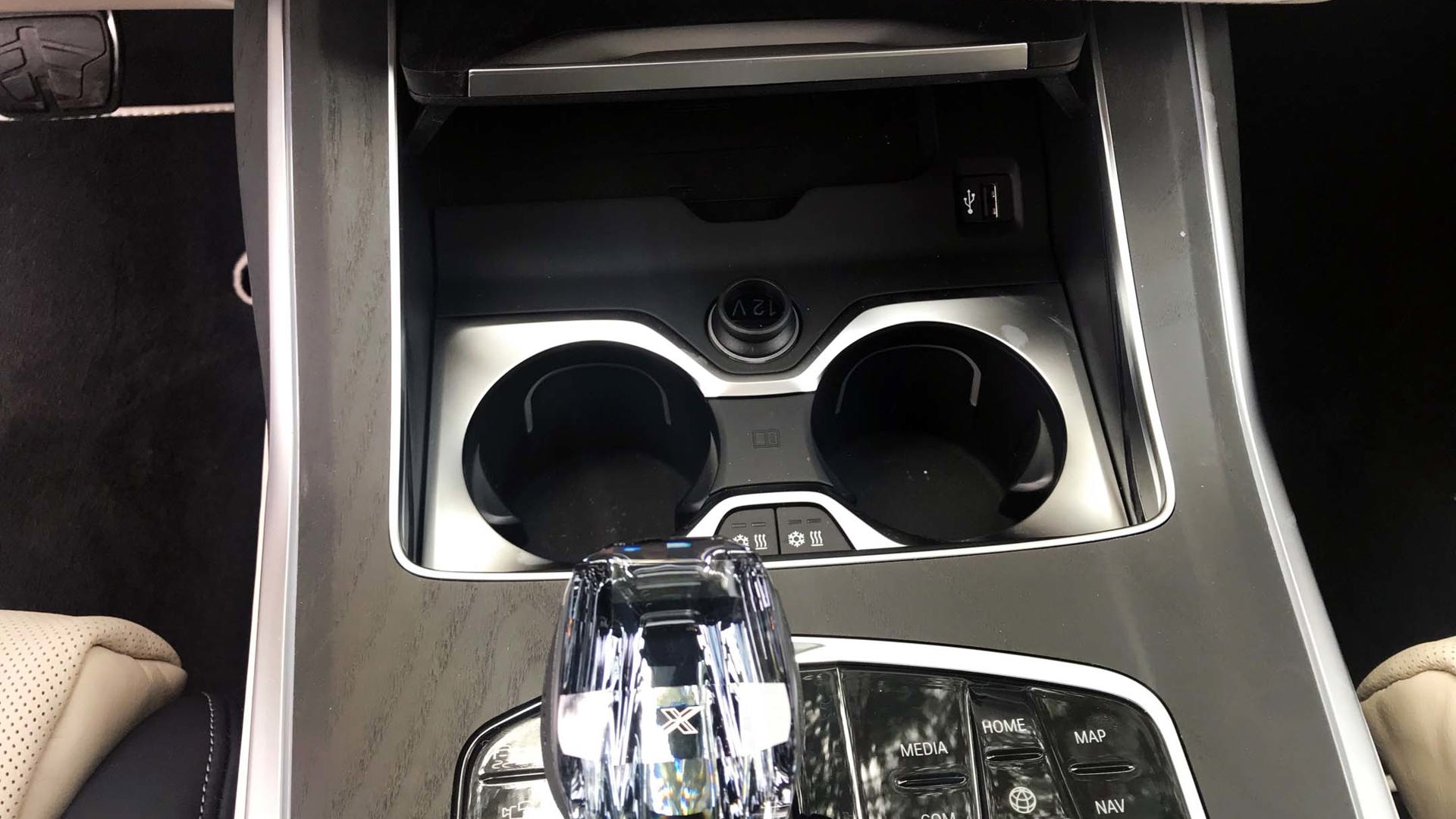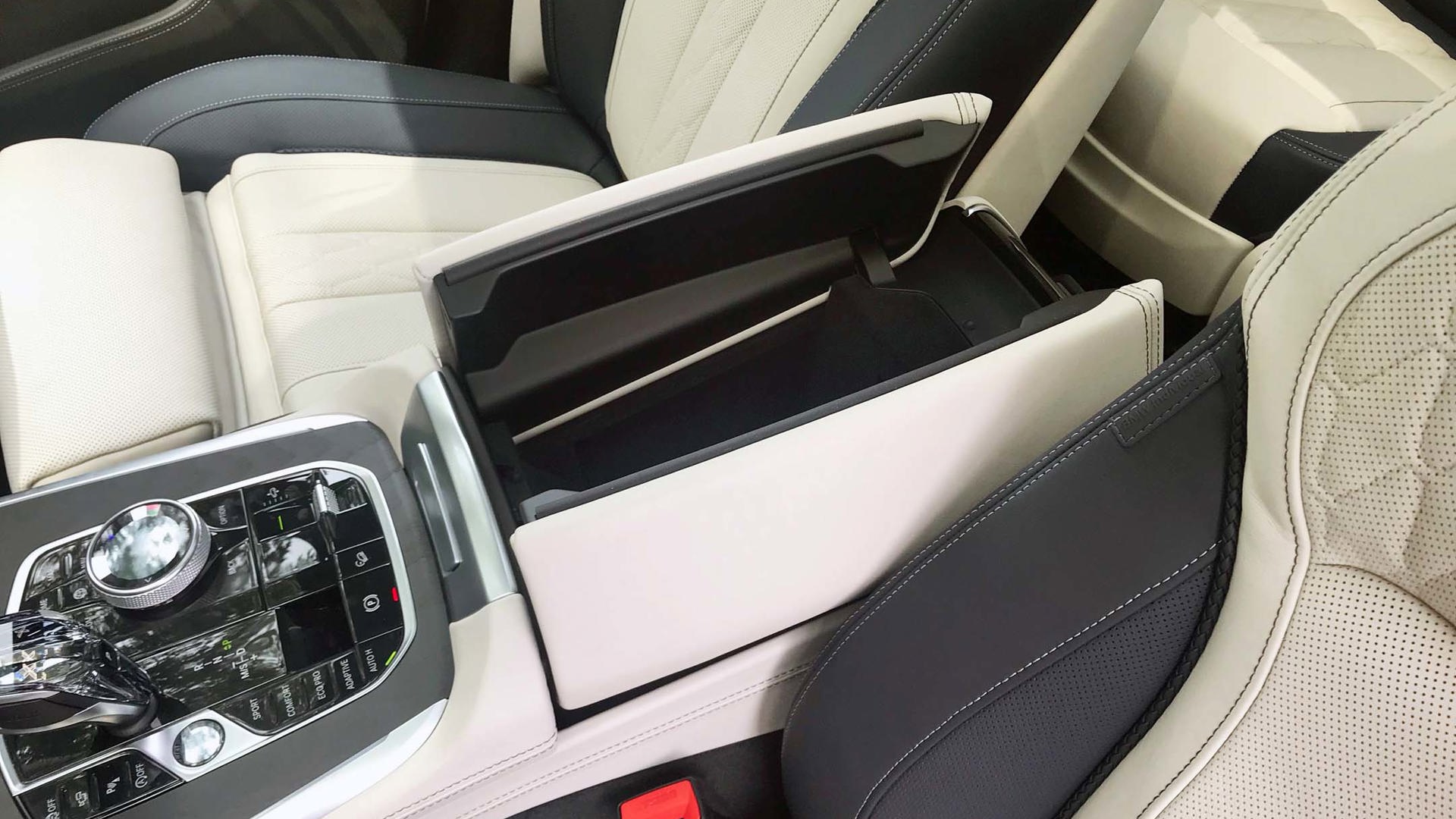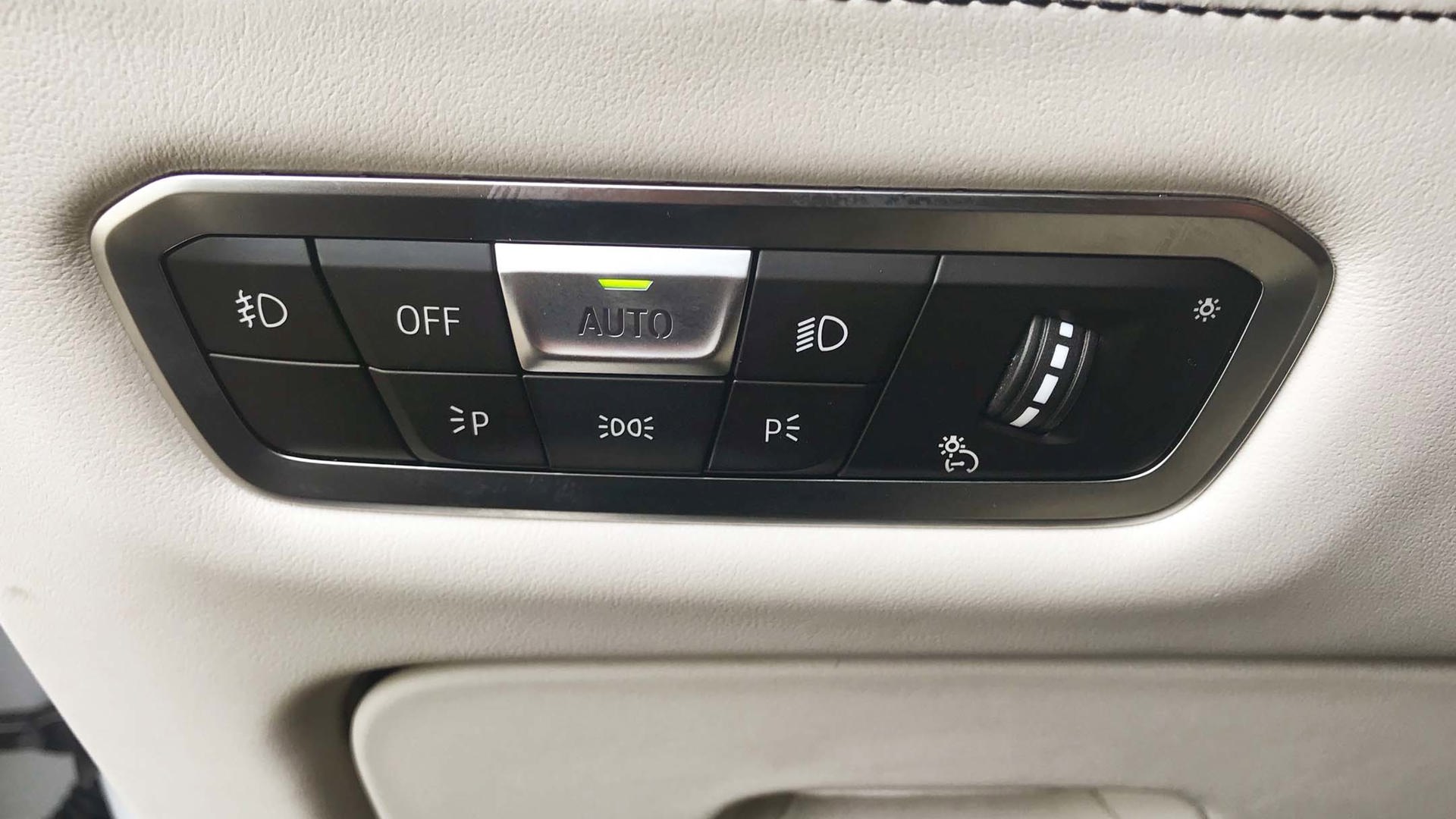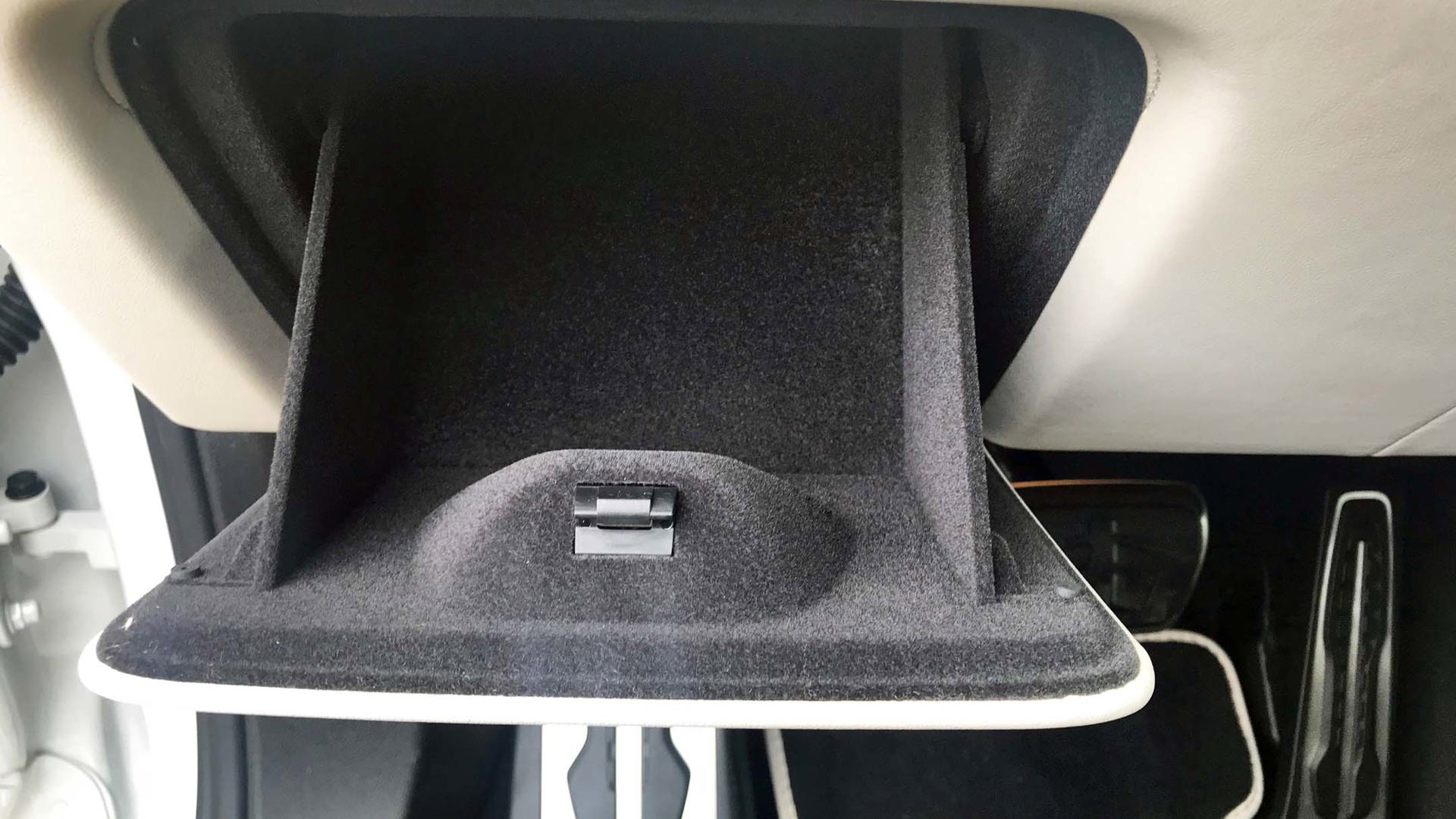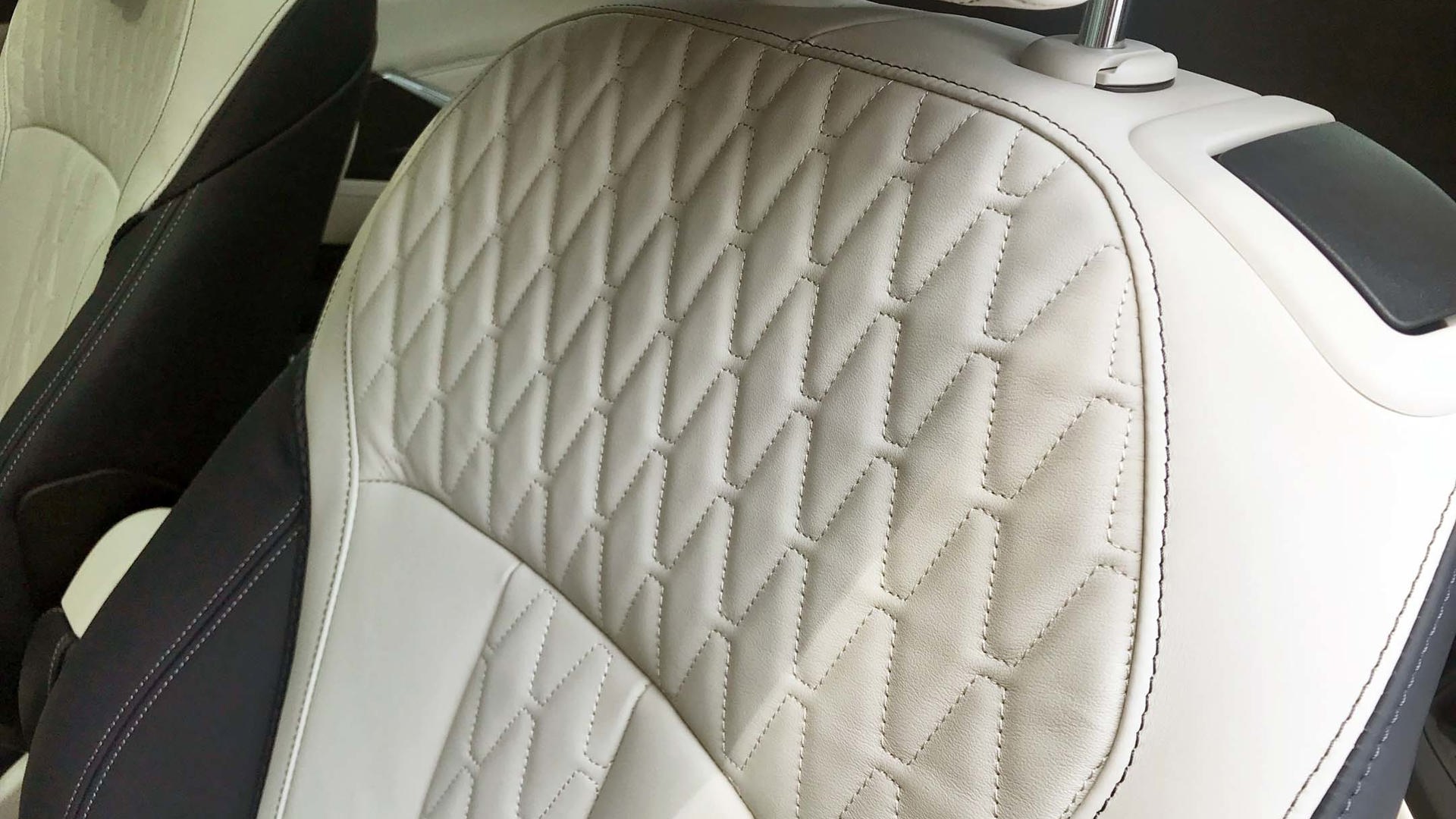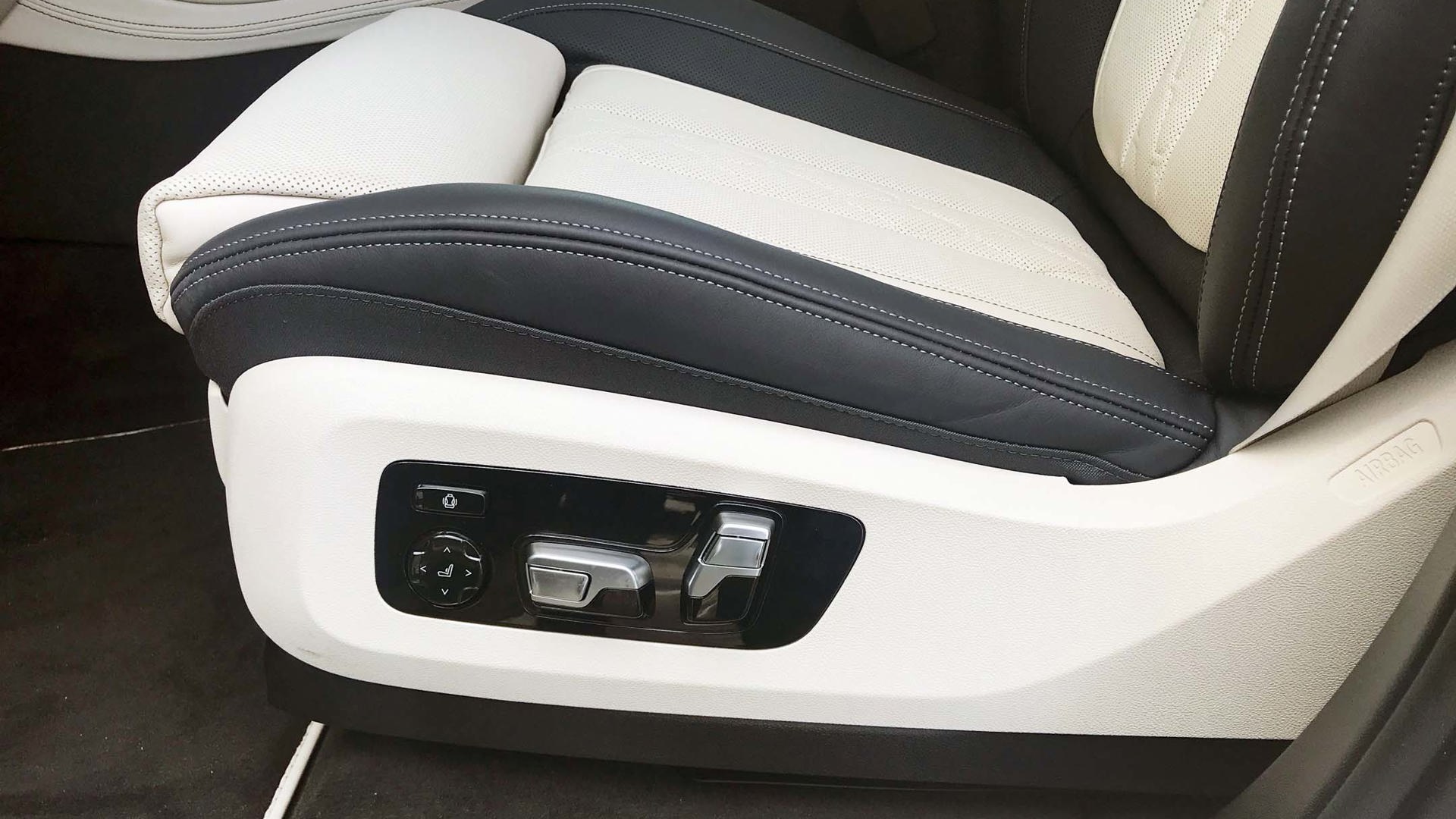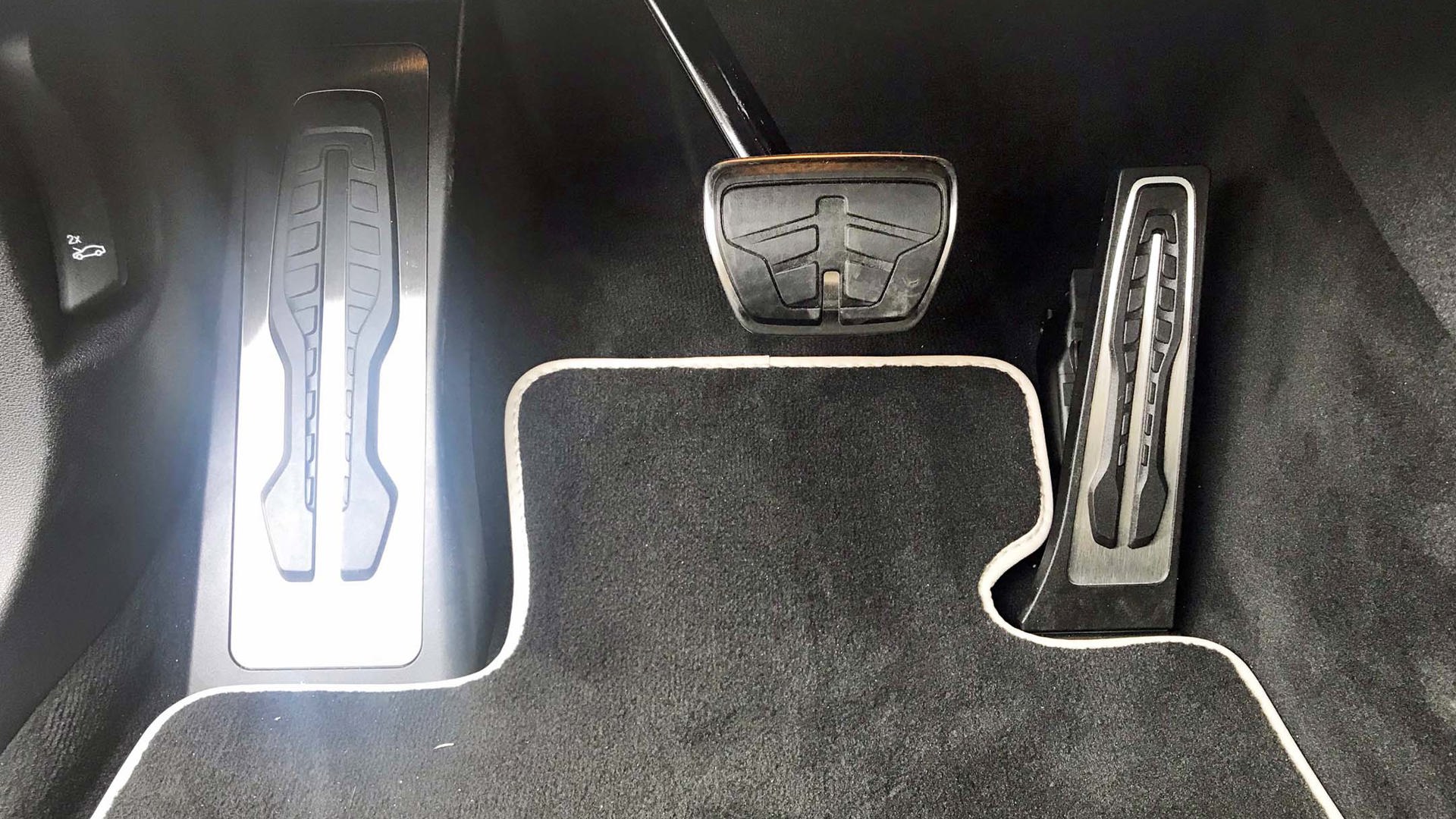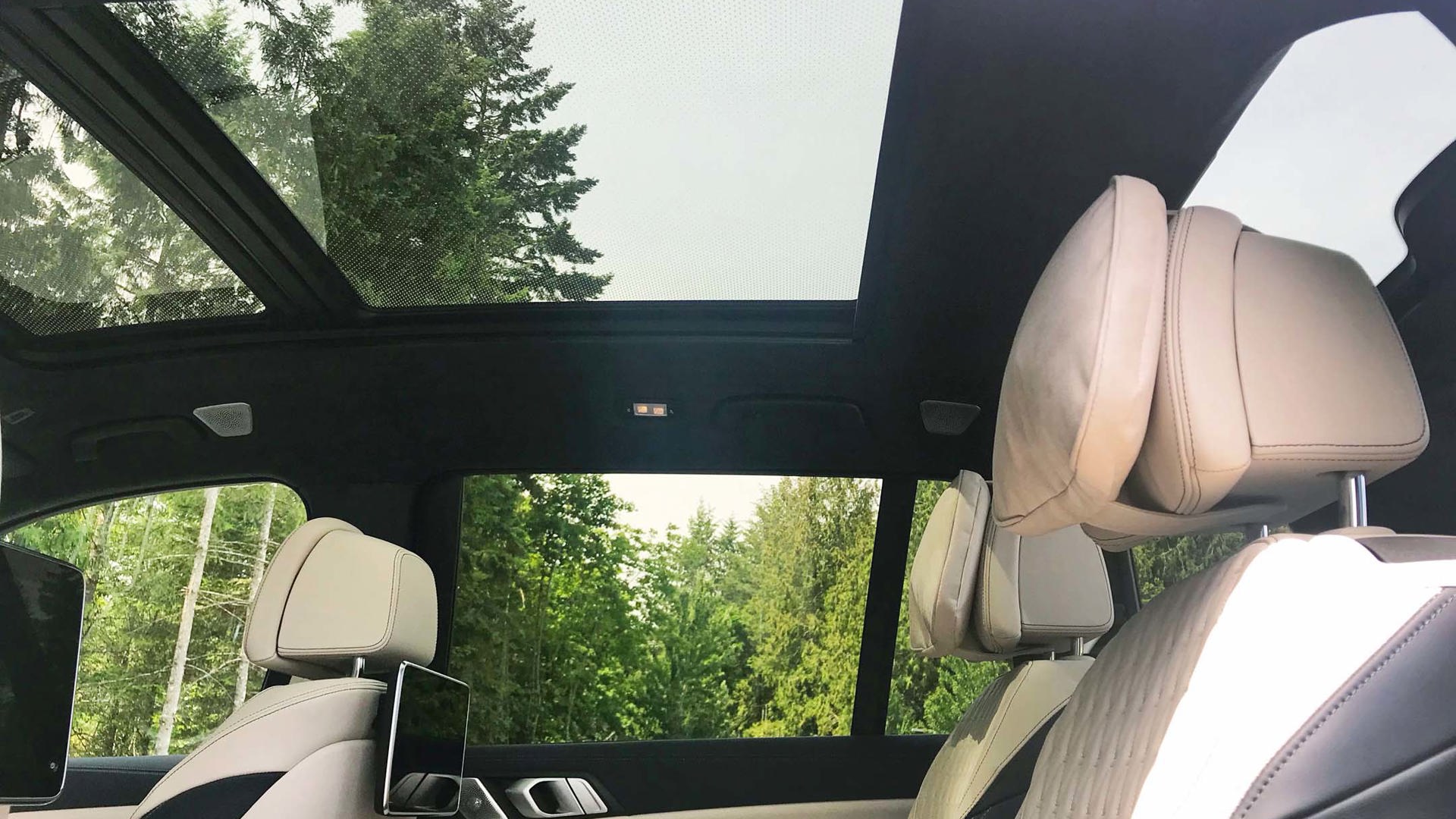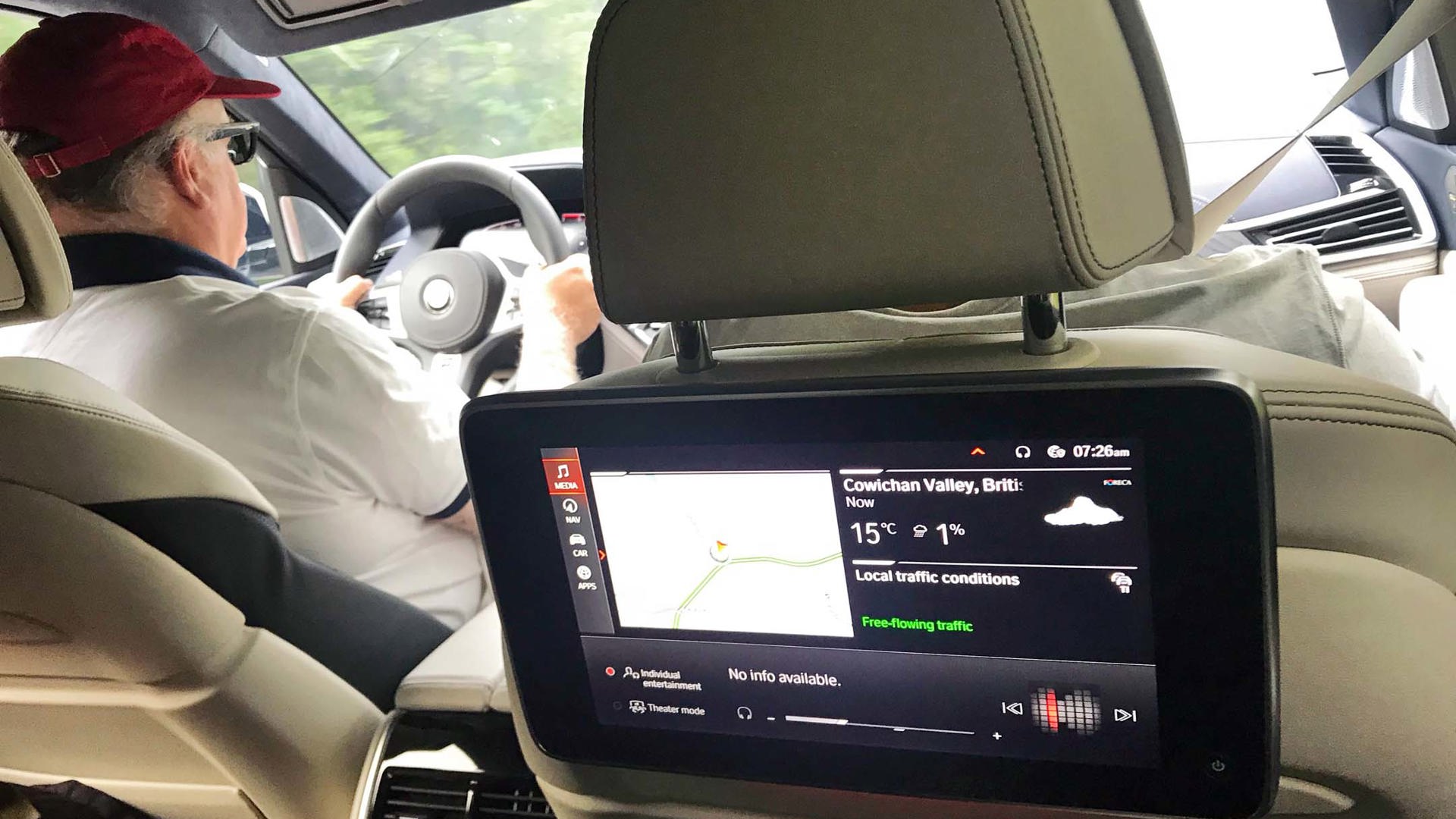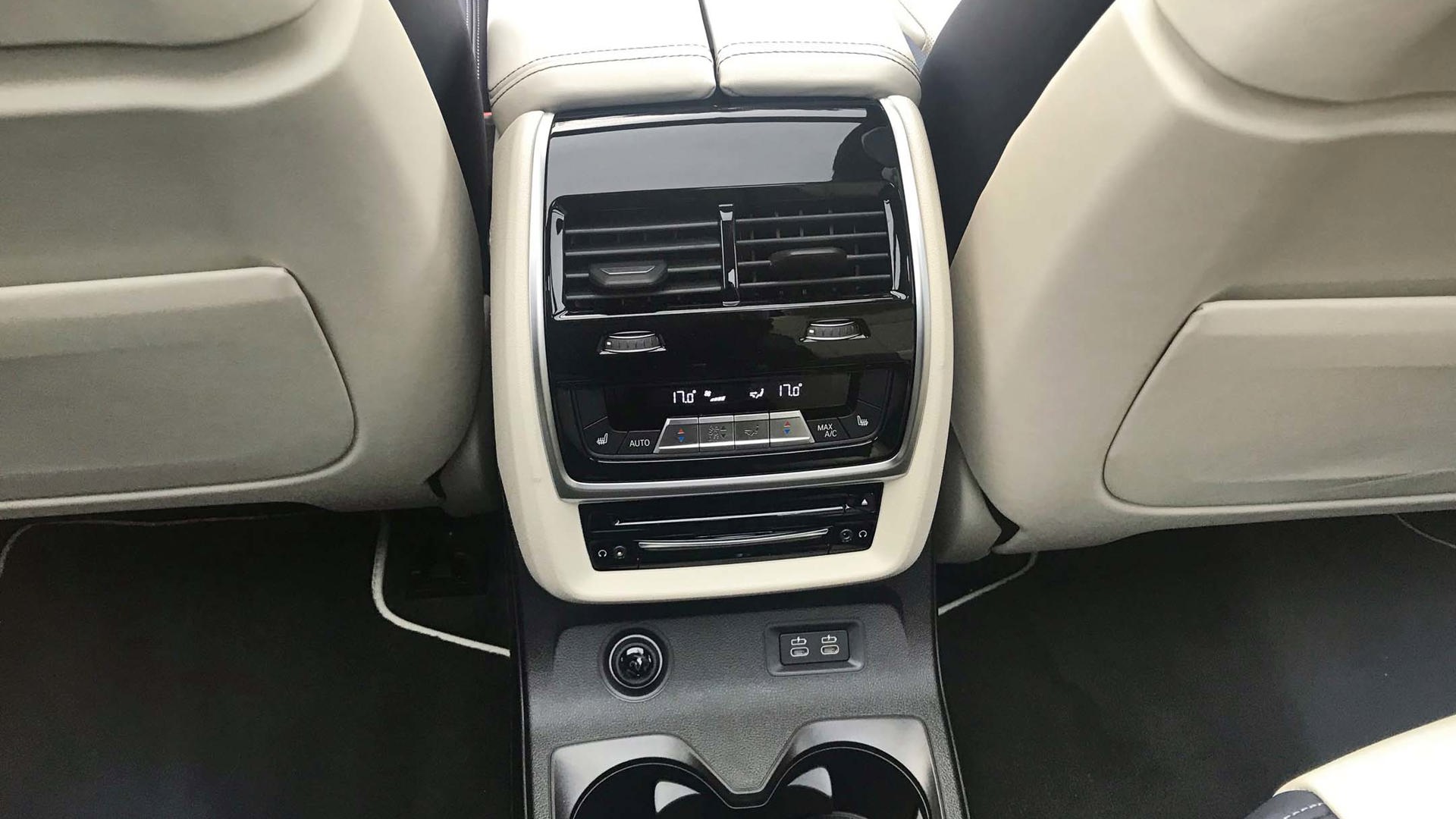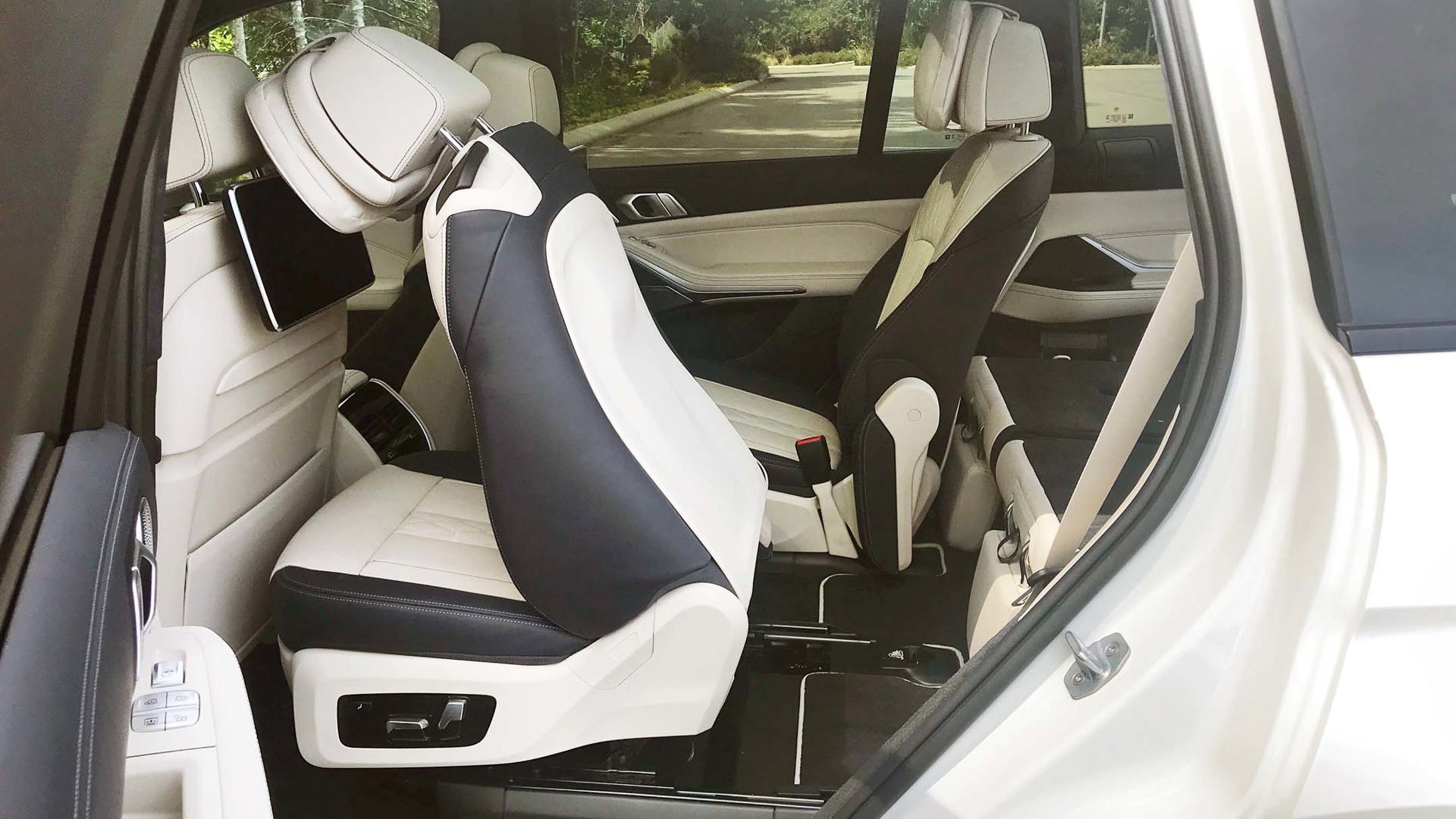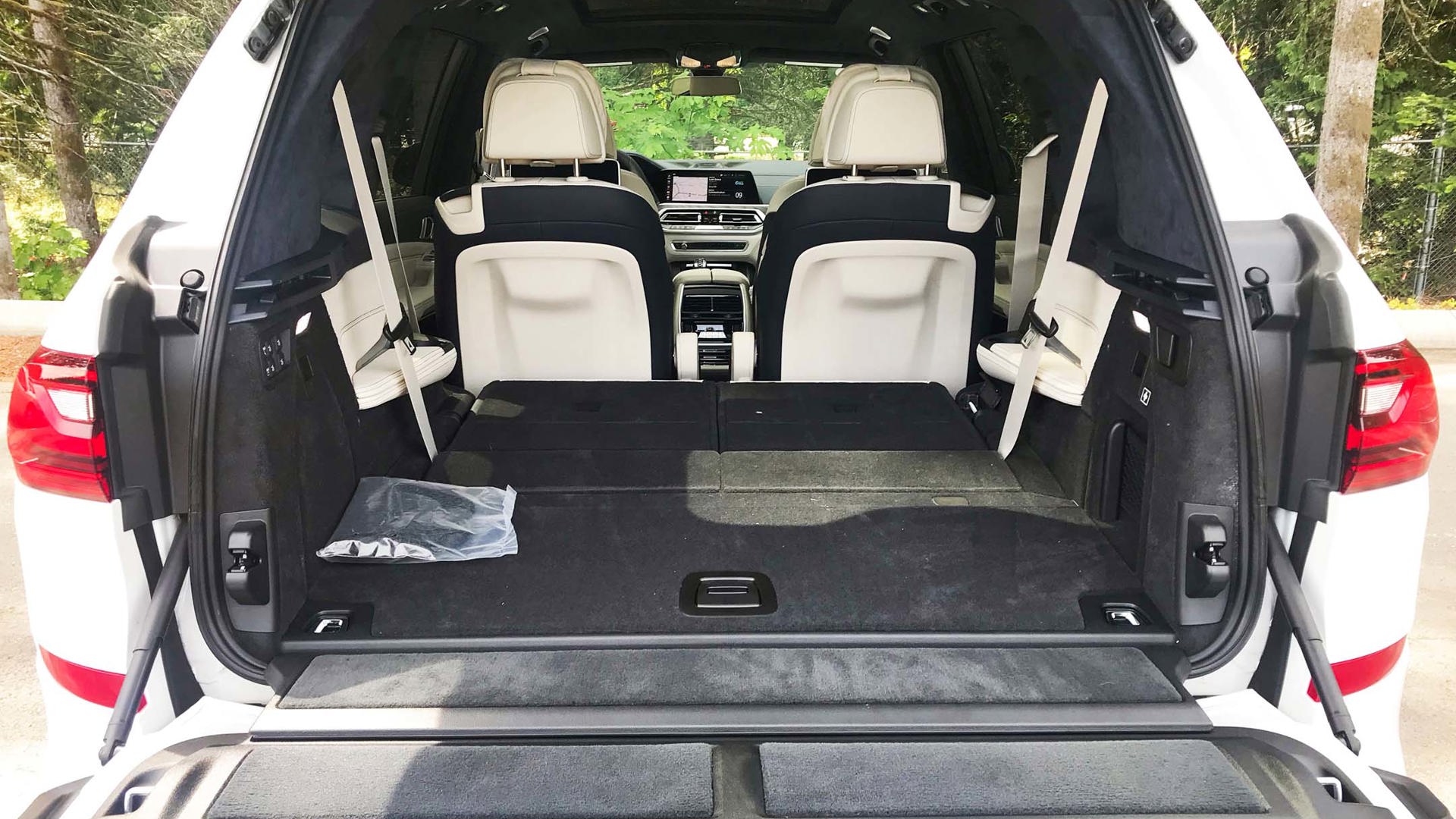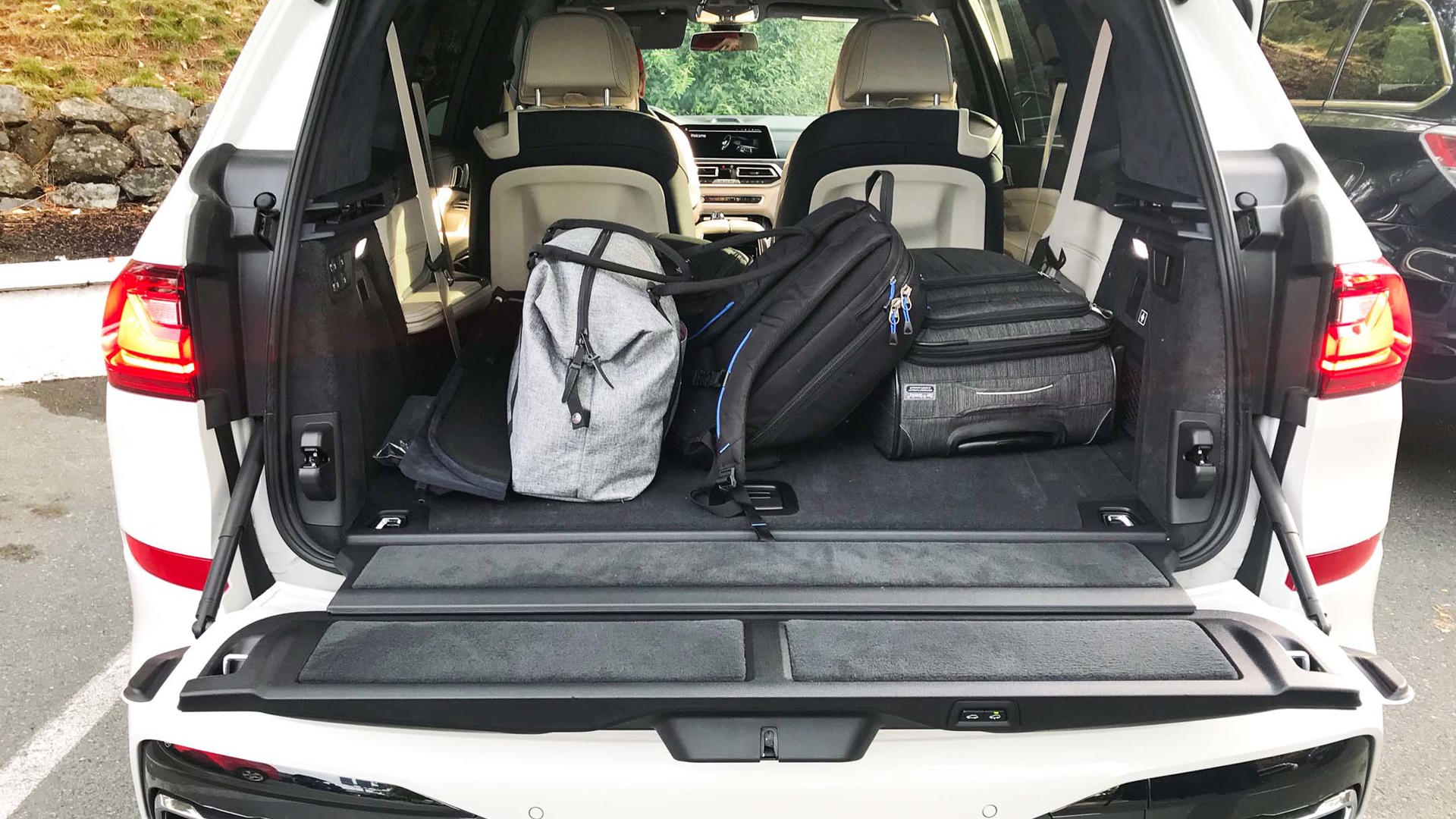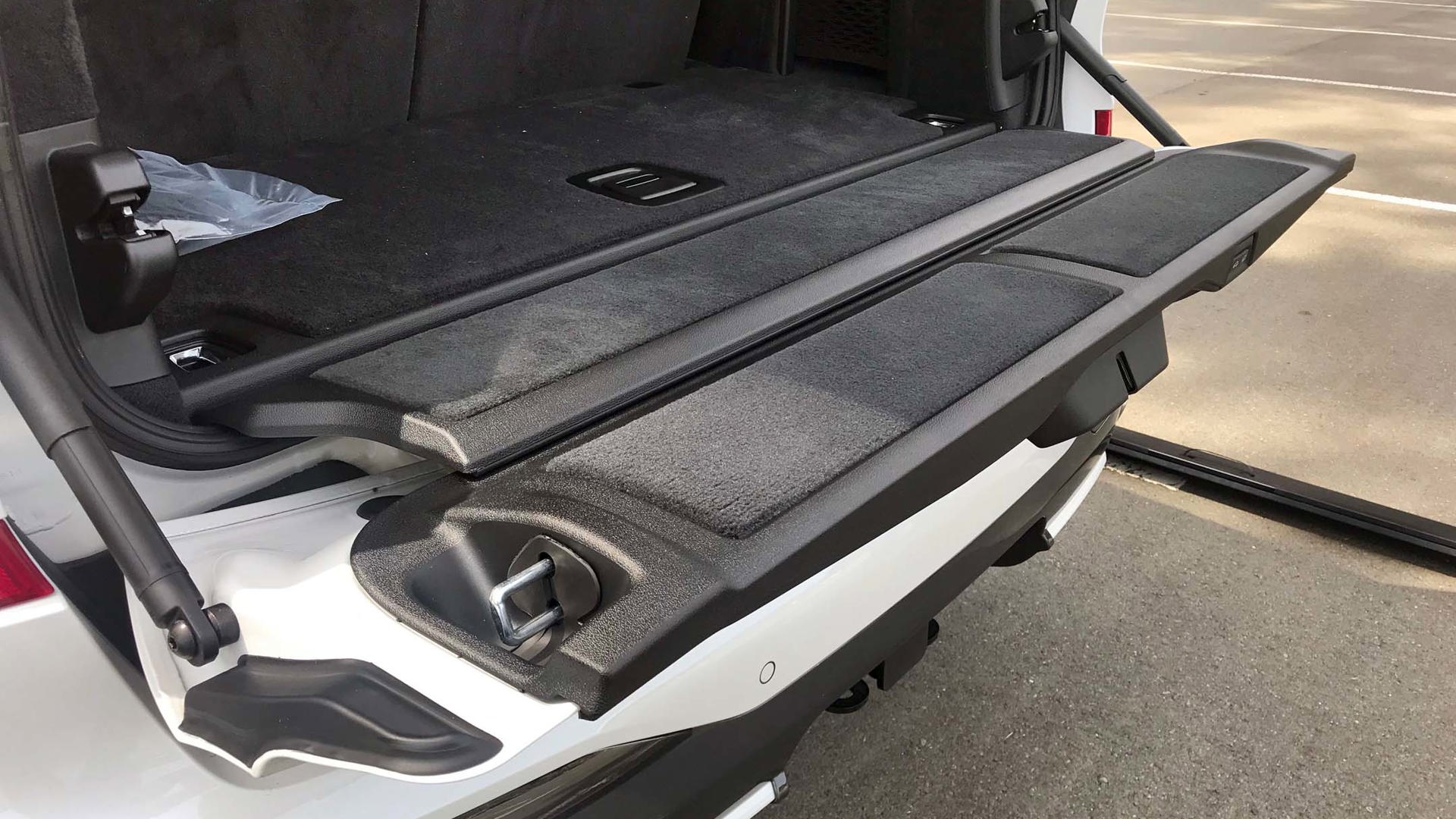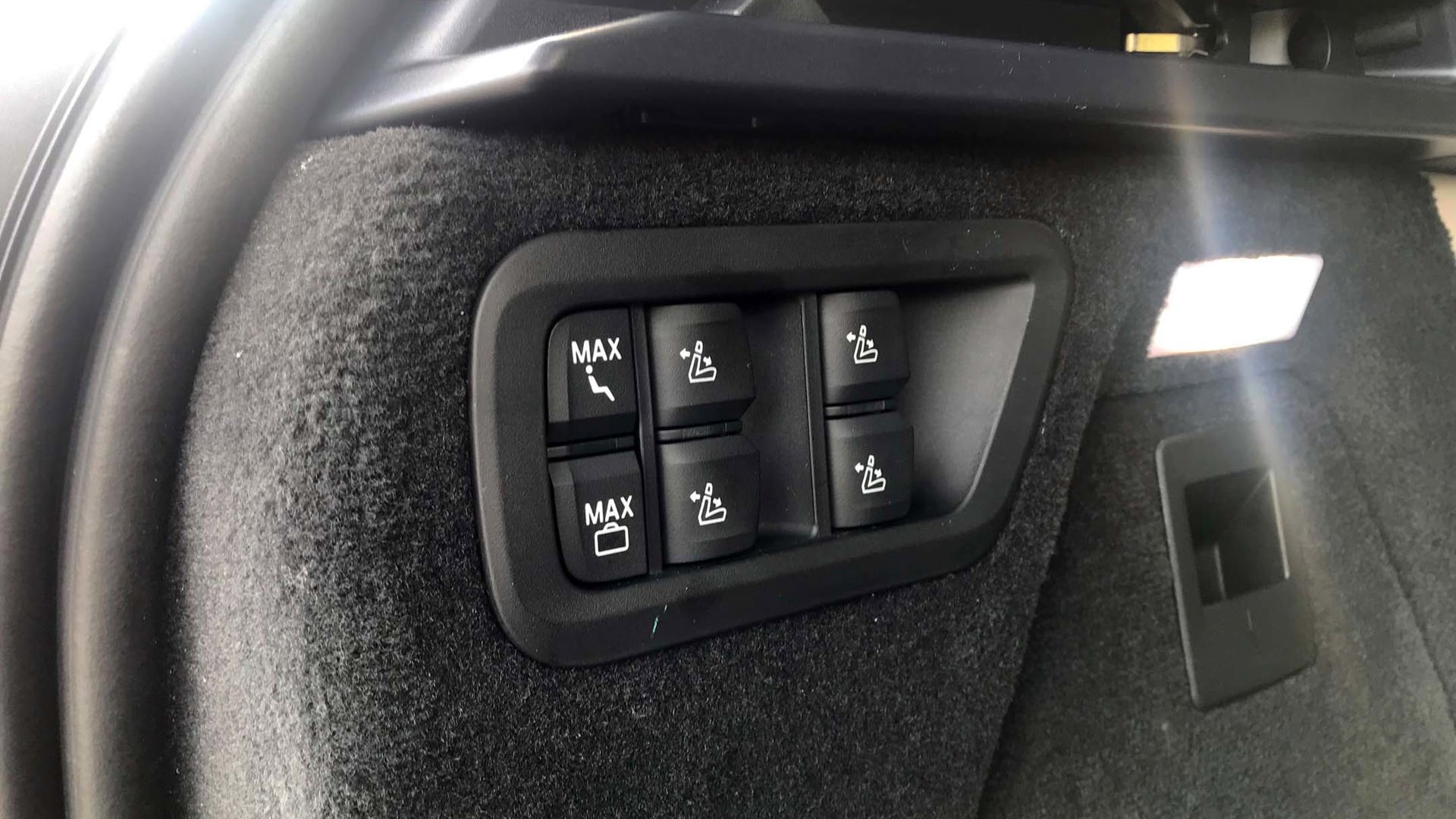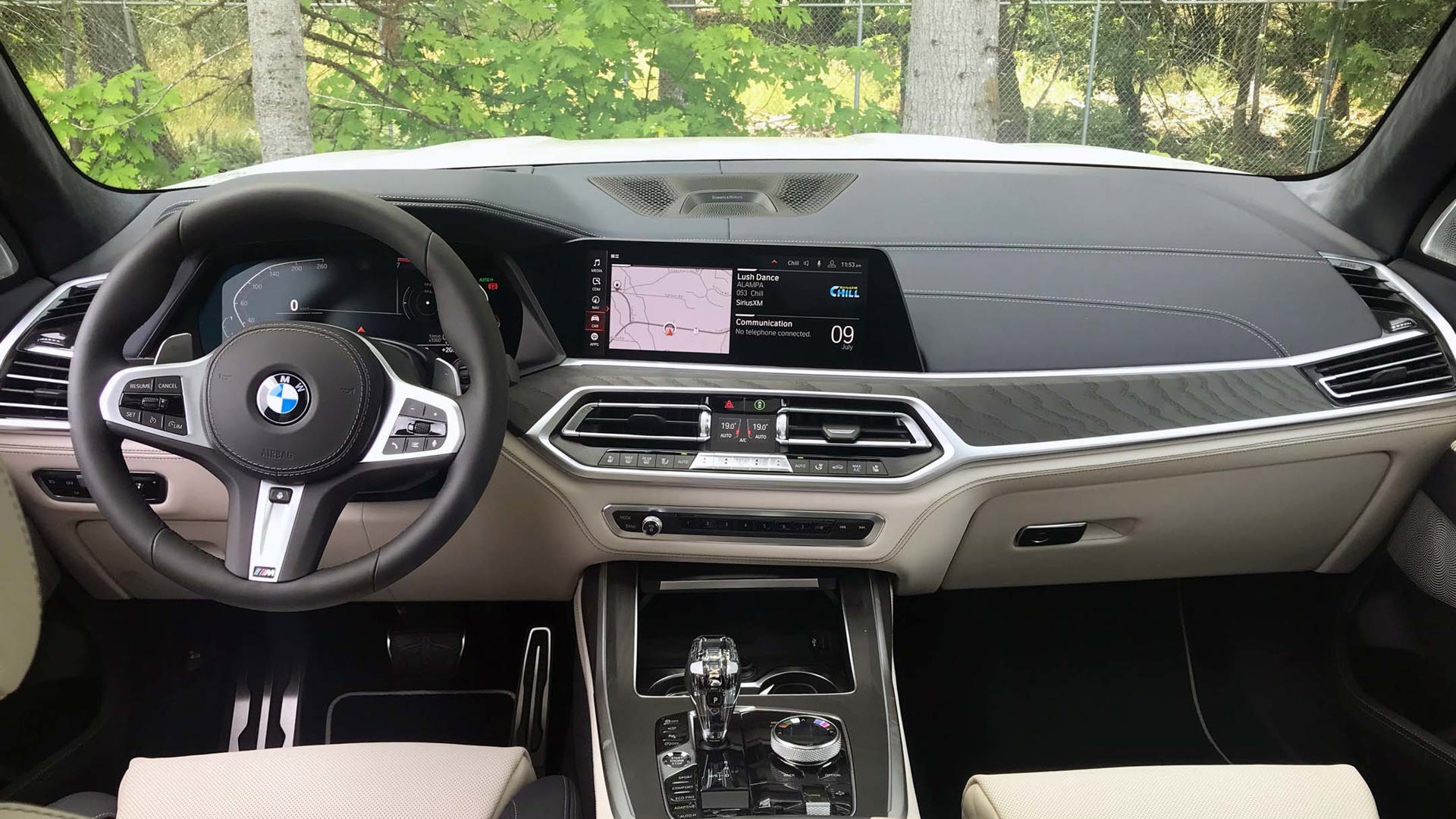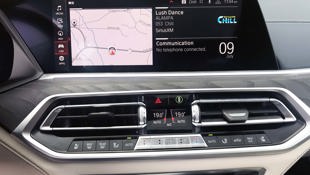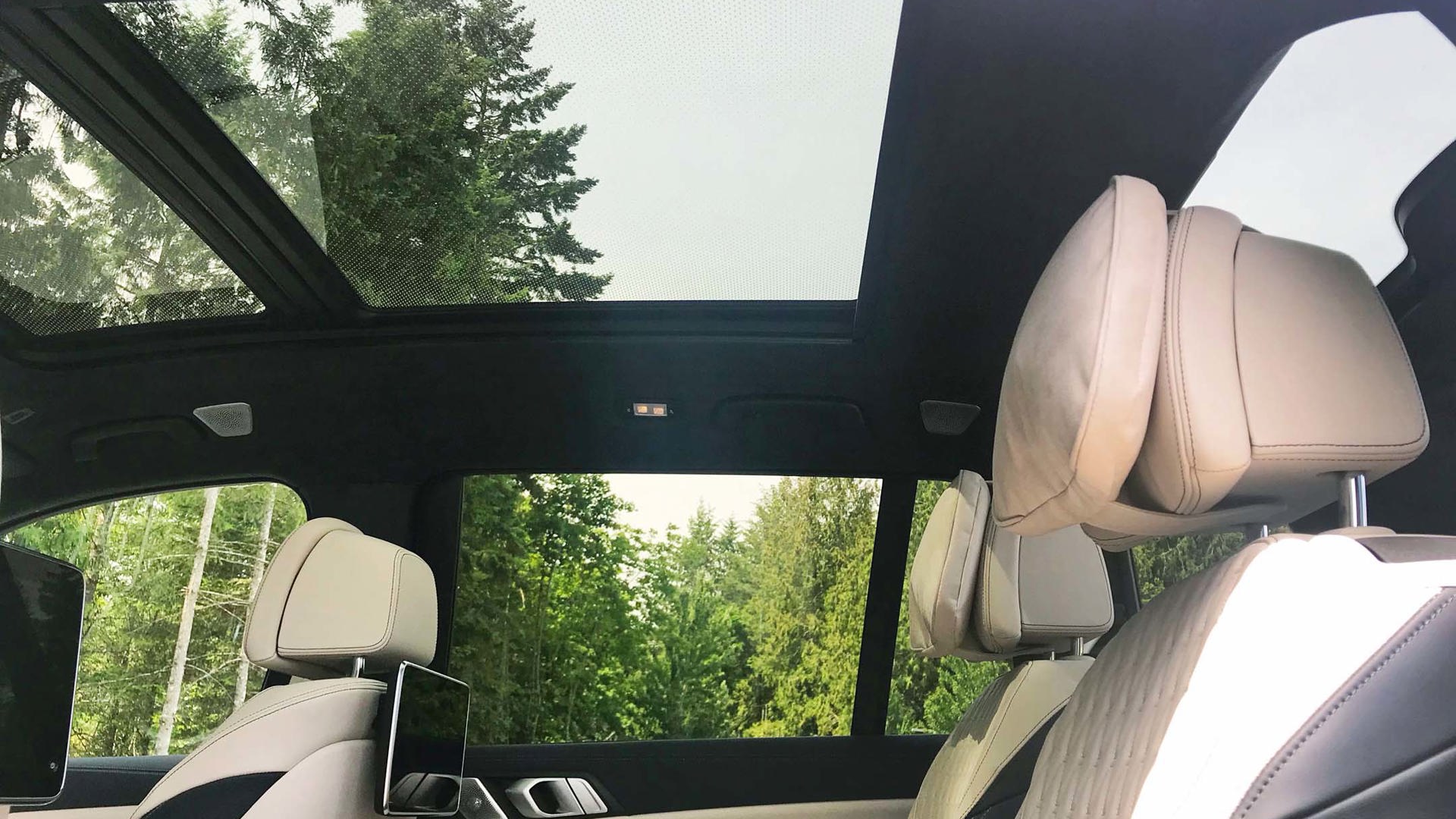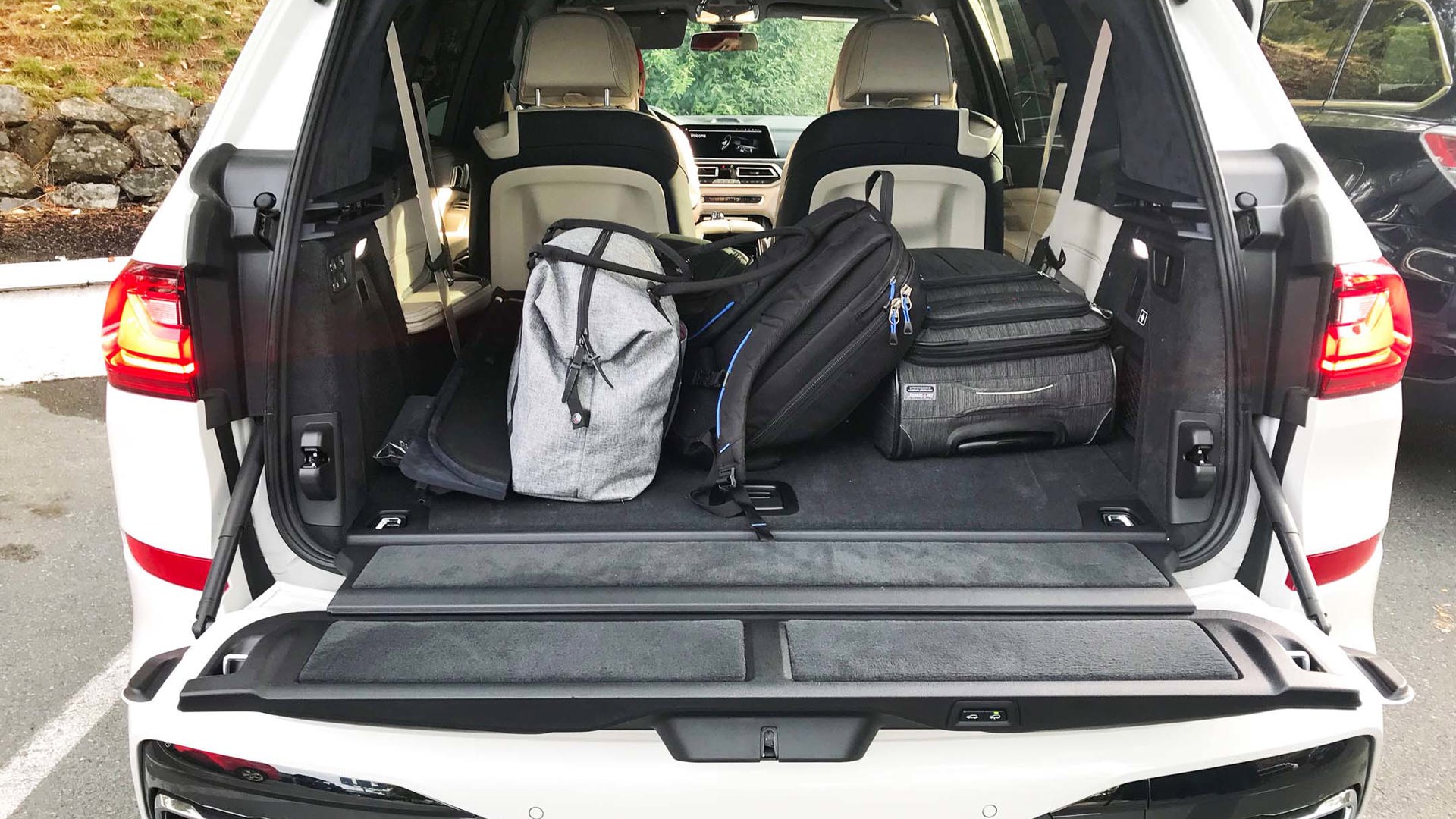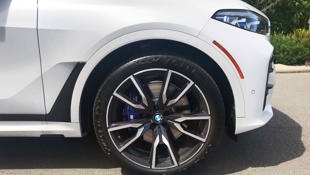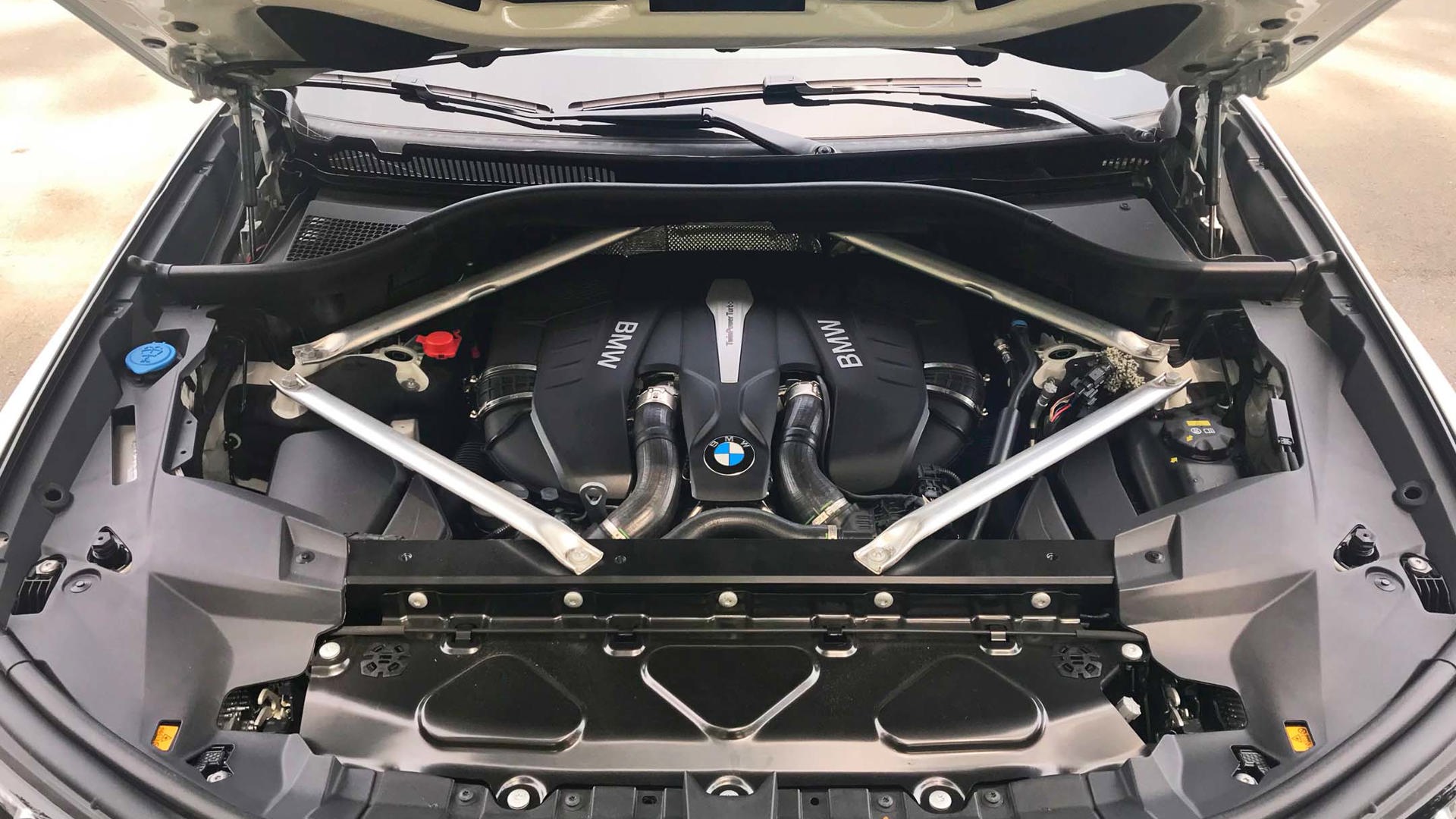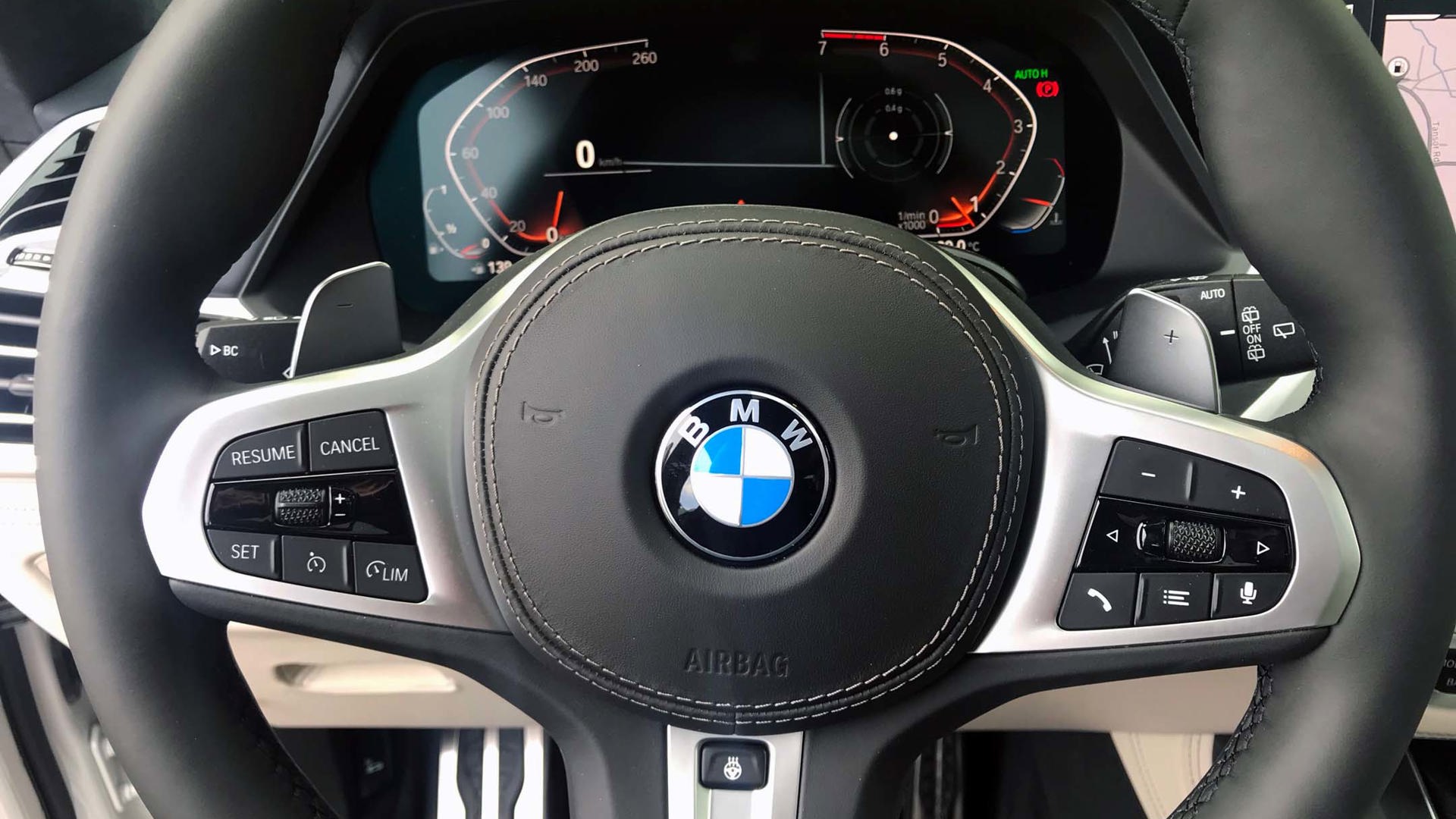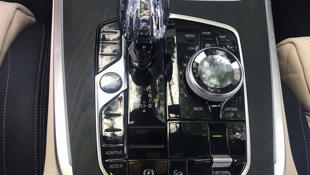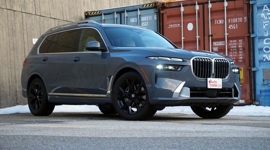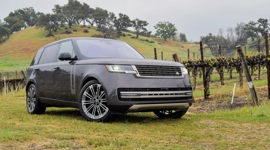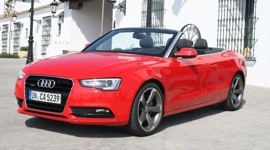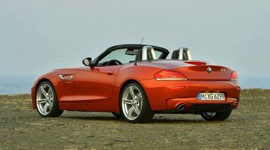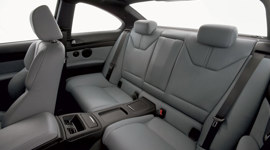 AutoTrader SCORE
AutoTrader SCORE
-
STYLING7/10
-
Safety8/10
-
PRACTICALITY8/10
-
USER-FRIENDLINESS7/10
-
FEATURES9/10
-
POWER8/10
-
COMFORT8/10
-
DRIVING FEEL8/10
-
FUEL ECONOMY6/10
-
VALUE7/10
MALAHAT, BC – Southern Vancouver Island is home to one of Canada’s great driving roads. Beginning in Victoria, the circular route heads west past the scenic town of Sooke, then northwest where it becomes a twisty, bumpy two-lane highway that traces the rugged west coast up to the rustic village of Port Renfrew. There, the road turns east, winding its way through picturesque mountain valleys and uninhabited Douglas Fir forests of Vancouver Island all the way to the east coast, where it joins the coast highway south to Victoria.
The X7’s quiet cabin and competent high-speed stability can be deceiving: you’re often travelling faster than you think you are.
In a BMW Z4 or M4, it’s a driver’s dream, but what exactly were we doing here in a full-size 2019 BMW X7 SUV? Aside from evaluating its roomy and feature-laden interior, configurable for six or seven passengers, we were curious to find out whether a BMW this big could – or even should – embody BMW’s DNA for driving performance. Our Vancouver Island route seemed like the perfect place to find out.
Styling: 7/10
Introduced earlier this year, the X7 is BMW’s newest and biggest SUV. In Canada, two X7 models are offered: the six-cylinder X7 xDrive40i (MSRP $92,500) and the V8-powered X7 xDrive50i (MSRP $110,100). For our test drive, we were given a top-of-the-line X7 xDrive50i with all the bells and whistles.
Much fun has been made of the X7’s extra-large twin kidney grilles but I suspect people will get used to seeing them on this relatively large SUV. Otherwise, the X7 is a nicely proportioned sport utility vehicle with a rather aggressive front end, attractive 22-inch alloy wheels, prominent side vents, blacked-out window trim, and twin exhaust outlets in the rear bumper.
The X7’s classy interior, as well as being well fitted with high-quality wood and leather, feels bright and spacious due in part to a large (standard) sunroof that covers the first and second rows and a second glass roof over the third row. As well, the side windows are extra large to bathe the cabin in light.
User Friendliness: 7/10
The all-new dash design in the X7 features BMW’s newest and largest digital instrument display, including a bright 12.3-inch display behind the steering wheel and another 12.3-inch touchscreen display in the centre dash. The digital speedometer and tachometer are separated by a large information screen that can include a navigation map, audio and telephone information, and other vehicle settings. The parking camera system – almost a necessity for a vehicle this size – provides a top-down view, wide-angle view, and 3D view.
But though the instruments are attractive, I had trouble warming up to the unusual shape and colour of the speedo and tachometer which emphasize colour and style over readability – X7 xDrive50i models feature a head-up display as standard, which helps. As well, the traditional heating and air conditioning controls in the centre dash include many small buttons that are hard to read, particularly in the glare of sunlight.
Moving further down the cabin, BMW made it easy to reconfigure the seating arrangements with electrically operated first-, second-, and third-row seats. Both second- and third-row seats have powered buttons, including a single button on the captain’s chairs (if equipped) that will move them forwards and fold the seatbacks for access to the third row. Similar switches are on the passenger door jamb and in the cargo compartment – an additional switch in the latter cluster will lower the air suspension to make loading easier.
The white leather upholstery and white seatbacks in our test vehicle are likely to get scuffed very quickly, particularly if children are on board. In a nutshell, the X7’s interior is very pretty but not entirely user-friendly.
Features: 9/10
The X7’s centre console contains a shift lever with an expensive-looking “crystal” handle, large round iDrive controller, and a bunch of switches and buttons: engine start/stop, infotainment menu shortcuts, drive mode (Sport, Comfort, Eco Pro, and Adaptive), air suspension height adjustment, downhill assist for steep declines, idle-stop deactivation, ESC deactivation, parking sensors, and the electric parking brake switch. That might seem like a lot of switches in one place, but personally I’m glad to see hard buttons rather than hard-to-find menus in the touchscreen.
For most X7 owners, the standard 205-watt, 10-speaker audio system in the X7 xDrive 40i and the Harmon Kardon surround sound system in the X7 xDrive50i will suffice; but true audiophiles may want to opt for the optional $4,900 Bowers & Wilkins Diamond Surround system with 1,500 watts and 20 speakers. To keep the kids happy in the back seat, there’s also an optional rear seat entertainment system with two 10.2-inch HD touchscreen displays, Blu-ray compatible DVD player, HDMI socket, and two headphone jacks.
Comfort: 8/10
At 5,151 mm in length, 2,000 mm in width, and 1,805 mm in height with a wheelbase of 3,105 mm, the X7 is bigger than many other full-size luxury SUVs such as the Audi Q7 and Q8, Volvo XC90, and Lexus RX L; but is slightly smaller than the redesigned 2020 Mercedes-Benz GLS arriving this autumn.
The X7’s long 3,105 mm wheelbase provides room for three-row seating with six- or seven-passenger capability depending on whether buyers choose two captain’s chairs or a three-seat bench for the second row. First- and second-row seats are extremely comfortable and have plenty of legroom and headroom. The second row, whether you choose the bench or captain’s chairs, has power-operated fore–aft adjustment to distribute legroom between the rear rows as needed, but unlike the front seats, don’t have height adjustment.
Though the X7’s third-row two-passenger seat will fit an average-sized adult, I found that getting into the third row was awkward: while the rear doors have a larger opening than the front doors, the step up is high; and though the second-row seats fold forward, the gap between the door jamb and the seat is rather narrow. The third seat is probably best suited for children, in my opinion.
Practicality: 8.5/10
With all three rows upright, there’s not a lot of cargo room behind the third row, at 300 litres. In seven-passenger models with second- and third-row seatbacks folded, maximum cargo space rises sevenfold to 2,120 L. Six-passenger X7s have less maximum cargo room (1,500 L) because the second-row captain’s chairs don’t fully fold down.
The X7’s rear liftgate is split into two parts: a small, drop-down tailgate and a lift-up hatch – both power-operated. The drop-down tailgate acts like a table to rest heavy objects on before sliding them into the trunk; however, I’m not sure if this benefit outweighs the ease and simplicity of a traditional one-piece liftgate.
Power: 8/10
While the X7 40i has BMW’s silky-smooth turbocharged 335 hp 3.0-litre inline-six with 330 lb-ft torque; the X7 50i sports an upgraded 456 hp 4.4-litre twin-turbo V8 with 479 lb-ft of torque. Both models come with an improved eight-speed automatic Steptronic transmission with shift paddles for manual shifting, and BMW’s xDrive all-wheel-drive system as standard.
With 456 horsepower, the 2,548 kg (5,617 lb) X7 xDrive50i can zip from zero to 100 km/h in just 5.4 seconds (the xDrive40i does it in 6.1 seconds) – and it does it with an exhaust note that could be mistaken for a NASCAR race car.
That said, X7 drivers can manually choose the level of performance, comfort, and fuel economy they want simply by pressing the appropriate button on the centre console. In our test drive, I found that the stiffer suspension settings, quicker gear changes and increased power in Sport mode was ideal for brisk driving over curvy roads, while the softer suspension travel and relaxed gear changes in Comfort mode was all that’s needed for a leisurely drive.
Fuel Economy: 6/10
Given the X7’s size and weight, fuel consumption is understandably thirsty. The six-cylinder X7 xDrive40i manages 12.0 L/100 km city, 9.4 highway, and 10.8 combined; the V8-powered X7 xDrive50i consumes 14.3 L/100 km city, 10.6 highway, and 12.6 combined. X7 owners who want to maximize fuel economy can choose the Eco Pro mode. In Comfort or Eco Pro mode, the powertrain decouples from the axles between 15 and 160 km/h when coasting to save fuel. As well, the X7’s transmission will change gears proactively based on information provided by the navigation system and a front radar sensor that can see upcoming gradient changes or vehicles ahead.
In addition, data provided by the navigation system and front camera can cancel the activation of the automatic idle-stop system when approaching brief stops at roundabouts or slow-moving traffic. All of this happens independently of the driver, who remains blissfully unaware of these optimizations that balance fuel consumption with responsiveness.
Driving Feel: 8/10
Despite its substantial curb weight, tall ground clearance, and tall height, the X7 doesn’t wallow like a whale when cornering at speed. This is mostly due to BMW’s advanced suspension technology that uses electronic safety systems to compensate for dynamic vehicle motions and road conditions. That begins with the X7’s fully independent suspension that incorporates compressed air shocks, which not only keep the vehicle level but actively adjust damping firmness for speed and road surface. Using a front camera, the X7 sees the road surface ahead and proactively adjusts the suspension to accommodate the road. As well, when the driver selects Sport mode, the suspension is automatically lowered by 20 mm to improve handling. For off-road use, the driver can raise the body by 40 mm to increase ground clearance. There’s also an optional Off-Road Package that includes four driver-selectable modes for sand, gravel, rocks, and snow.
The X7 compensates for slippery surfaces with standard xDrive all-wheel drive which is capable of varying torque between the front and wheels as needed, sending up to 100 percent of torque to the rear wheels when necessary. As well, the X7’s standard rear differential lock can vary torque between the rear wheels by locking the spinning wheel and sending power to the wheel with the most traction. Again, when it’s working, the driver hardly notices what’s going on.
The X7 also features standard four-wheel steering to enhance manoeuvrability and stability. At slow speeds the rear wheels turn slightly in the opposite direction to the front wheels to decrease the turning radius for tighter turns. At high speeds, the rear wheels turn slightly in the same direction as the front wheels providing quicker turn-in, faster lane changes, and better stability.
During our spirited drive over a variety of smooth and undulating road surfaces (but no rain) the X7 felt quite stable and secure in Sport mode although there was noticeable lean in tight corners at speed. From a driving perspective, the X7 doesn’t feel like a big, heavy SUV; rather it feels smaller and more manoeuvrable than it should be. The ride is well damped even at its stiffest setting and the body and suspension don’t make any intrusive noises. Apart from the sporty exhaust roar when accelerating, the cabin is very quiet with little wind or tire noise. The X7’s quiet cabin and competent high-speed stability can be deceiving: you’re often travelling faster than you think you are.
Safety: 8/10
The X7 is equipped with a host of preventive safety features to help avoid collisions: these include blind spot warning, lane-departure warning, rear collision warning, frontal collision warning that includes pedestrian and cyclists; rear cross-traffic warning, active lane-keeping assist which steers the car back into its lane, and traffic jam assistant to keep a safe distance in heavy traffic.
Of these, the active lane-keeping assist is the most annoying, and potentially dangerous at times. For example, attempting to pass a cyclist by steering over the centre line results in the active steering attempting to steer the vehicle back into its lane. The driver can override the active steering but with some force. Fortunately, this safety feature can be turned off.
Value: 7/10
The 2019 BMW X7 XDrive 40i starts at $92,500 while the X7 XDrive 50i starts at $110,100. Though expensive, it’s in the same ballpark as other premium SUVs.
Packages on the X7 xDrive 40i include: Advanced Driving Assistant Package ($2,000), Dynamic Handling Package ($4,750), M Sport Package ($2,900), Premium Enhanced Package ($7,000), and Premium Excellence Package ($15,000).
The X7 xDrive 50i also offers an optional Premium Package ($8,000), and Two-tone Night Blue Package ($2,500).
Standalone options on the X7 include: six-seat configuration with two centre captain’s chairs instead of a bench ($750); premium leather interiors in various hues; a choice of interior wood and high-gloss trim surfaces; premium Bowers & Wilkins sound system ($4,900); panoramic glass sunroof; different wheels designs; aluminum running boards ($800); off-road package ($2,950); and trailer hitch ($750). Some of these individual options are also available as part of an option package.
The 2019 BMW X7 is produced in Spartanburg, South Carolina, along with the X3, X4, X5 and X6.
Conclusion
As might be expected, the full-size 2019 BMW X7 is a comfortable, roomy, luxurious, and powerful utility vehicle with all the latest technology gadgetry, a three-row interior and competent all-weather traction. What is unexpected – but not surprising, given the badge on the hood – is its capable handling and manoeuvrability for such a big and heavy vehicle.
| Engine Displacement | 4.4L |
|---|---|
| Engine Cylinders | V8 |
| Peak Horsepower | 456 hp @ 5,250–6,000 rpm |
| Peak Torque | 479 lb-ft @ 1,500–4,750 rpm |
| Fuel Economy | 14.3/10.6/12.6 L/100 km cty/hwy/cmb |
| Cargo Space | 300 L / 1,500 L seats down (2,120 L for seven-seat configuration) |
| Model Tested | 2019 BMW X7 xDrive50i |
| Base Price | $110,100 |
| A/C Tax | $100 |
| Destination Fee | $2,480 |
| Price as Tested | $129,930 |
|
Optional Equipment
$17,250 – Advanced Driving Assistant Package $2,000; Dynamic Handling Package $4,750; Premium Package $8,000; and Two-tone Night Blue Package $2,500
|
|
